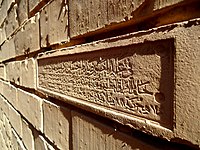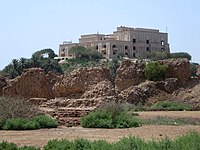User:Kharbaan Ghaltaan/Saddam Hussein
Saddam Hussein | |
|---|---|
صدام حسين | |
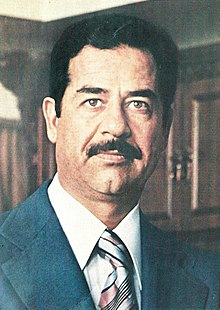 Saddam in 1998 | |
| 5th President of Iraq | |
| In office 16 July 1979 – 9 April 2003 | |
| Prime Minister |
|
| Vice President |
|
| Preceded by | Ahmed Hassan al-Bakr |
| Succeeded by | |
| Chairman of the Revolutionary Command Council | |
| In office 16 July 1979 – 9 April 2003 | |
| Preceded by | Ahmed Hassan al-Bakr |
| Succeeded by | Office abolished |
| Prime Minister of Iraq | |
| In office 29 May 1994 – 9 April 2003 | |
| President | Himself |
| Preceded by | Ahmad Husayn Khudayir as-Samarrai |
| Succeeded by | Mohammad Bahr al-Ulloum (as Acting President of the Governing Council of Iraq) |
| In office 16 July 1979 – 23 March 1991 | |
| President | Himself |
| Preceded by | Ahmed Hassan al-Bakr |
| Succeeded by | Sa'dun Hammadi |
| Secretary General of the National Command of the Arab Socialist Ba'ath Party | |
| In office January 1992 – 30 December 2006 | |
| Preceded by | Michel Aflaq |
| Succeeded by | Izzat Ibrahim al-Douri |
| Regional Secretary of the Regional Command of the Iraqi Regional Branch | |
| In office 16 July 1979 – 30 December 2006 | |
| National Secretary |
|
| Preceded by | Ahmed Hassan al-Bakr |
| Succeeded by | Izzat Ibrahim ad-Douri |
| In office February 1964 – October 1966 | |
| Preceded by | Ahmed Hassan al-Bakr |
| Succeeded by | Ahmed Hassan al-Bakr |
| Vice President of Iraq | |
| In office 17 July 1968 – 16 July 1979 | |
| President | Ahmed Hassan al-Bakr |
| Preceded by | Ahmed Hassan al-Bakr |
| Succeeded by | Izzat Ibrahim al-Douri |
| Member of the Regional Command of the Iraqi Regional Branch | |
| In office February 1964 – 9 April 2003 | |
| Personal details | |
| Born | 28 April 1937[a] Al-Awja, Saladin Governorate, Kingdom of Iraq |
| Died | 30 December 2006 (aged 69) Camp Justice, Kadhimiya, Baghdad, Iraq |
| Cause of death | Execution by hanging |
| Resting place | Al-Awja, Saladin Governorate, Iraq |
| Political party |
|
| Spouses | |
| Children | |
| Signature | |
| Military service | |
| Allegiance | |
| Branch/service | Iraqi Armed Forces |
| Rank | Marshal |
| Battles/wars | |
Saddam Hussein Abd al-Majid al-Tikriti (28 April 1937 – 30 December 2006), known as Saddam Hussein was an Iraqi politician and revolutionary, who served as fifth president of Iraq from 1979 to 2003 and as second vice-president of Iraq from 1968 to 1979. He also hold the position of prime minister twice from 1979 to 1991 and from 1994 to 2003. Saddam was a prominent member of the Ba'ath Party and leader of the Baghdad based Iraqi regional branch.
After schooling from Baghdad, he joined Ba'ath Party in 1957. Following an unsuccessful coup overthrowing General Qasim in 1959, Saddam fled Iraq, spent in-exile in Egypt and studied at Cairo University. He returned to Iraq in 1963 after the Ba'athist coup and got prisoned. Saddam became vice-president of new Ba'athist state under the presidency of Ahmed Hassan al-Bakr, following the 1968 coup. He persided over the first and second Iraqi Kurdish War and signed a peace treaty with Mustafa Barzani in 1970. Saddam led "National Campaign", which eradicated illiteracy and provided free-medical. He turned Iraq into one of the most powerful and prosperous countries. In 1979, Saddam became president after the resignation of Al-Bakr. He ordered invasion of Iran in 1980 and fought the Iran–Iraq War, which ended in 1988. His government led Anfal campaign from 1986 to 1989 for suppressing Kurdish militants. Tensions with Kuwait increased over oil prices, which turned him to invade Kuwait and fought the Gulf War, which he lost to a coalition led by the United States.
After the 1990–1991 war, his relations with the United States remained tensed. Saddam repressed 1991 uprisings of Kurds and Shia. He adopted an anti-American stance and established the Faith Campaign, promoting Islamism in Iraq. As a result of the Gulf War, Iraq was effected by economic decline, until the it began improving the late 1990s. In 2003 the United States-led coalition force invaded Iraq, in pretext of Saddam's weapons of mass destruction program and having links with Al-Qaeda. Within weeks of occupation, he lost control over the country in the war and went in-hiding. Saddam was captured in December 2003 and faced trial from the interim government. He was sentenced to death by the Iraqi High Tribunal for killing of 148 Shia and was executed on 30 December 2006 at the age of 69.
A controversial persoanlity, Saddam's rule was marked by numerous human rights abuses, including an estimated 250,000 arbitrary deaths and disappearances. He is noted for brutal repression of political oppposition. Saddam is known for initiating many wars and conflicts. Most of the western powers viewed him as tyrant and authoritarian dictator. Conversely, many Arabs and Muslims regard Saddam for his nationalism and support of Palestinian cause. Future political instability and insurgency remained as an effect of the war, which was almost non-existence during the Ba'ath rule. Accusations on him for possessing weapons of mass destruction and having ties to terrorism came out to be false. This increased positive legacy of Saddam Hussein. According to a survey, 67% of Iraqis viewed the government of Saddam better than current one.
Early life
[edit]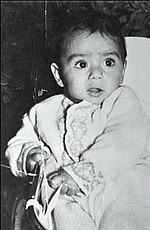
Saddam's full name was Saddam Hussein Abdul Majid al-Tikriti. He was born on 27 April 1937 to an Iraqi Arab Sunni peasant family, at the village of Al-Awja in Tikrit. Saddam traditionally belonged to Nasr tribe. His parents were
Hussein Abd Al-Majid and Subha Tulfah Al-Mussallat. They both were from the Albu Nasir tribe, a tribe that had descended from Ahmed Bin Hussein 'Nasiruddin' who was a descendant of Imam Hussein Bin Ali. The Albu Nasir tribe had settled in Tikrit after migrating from Yemen.[2][3] Saddam's brother and father both died of cancer before his birth. These deaths made Saddam's mother, Subha Tulfah al-Mussallat, so depressed that she unsuccessfully attempted to abort her pregnancy and commit suicide. His mother was saved by a neighboring Jewish family.[4] Subha "would have nothing to do with him," and Saddam would eventually be taken in by an uncle.[5]
His mother remarried, and Saddam gained three half-brothers through this marriage. His stepfather, Ibrahim al-Hassan, treated Saddam harshly after his return, and (according to a psychological profile created by the CIA) beat him regularly, sometimes to wake him up.[6][7] At around the age of 10, Saddam fled the family and returned to live in Baghdad with his uncle Khairallah Talfah, who became a fatherly figure to Saddam.[8] Talfah, the father of Saddam's future wife, was a devout Sunni Muslim and a veteran of the 1941 Anglo-Iraqi War between Iraqi nationalists and the United Kingdom, which remained a major colonial power in the region.[9] Talfah was later appointed the mayor of Baghdad during Saddam's time in power, until his notorious corruption compelled Saddam to force him out of office.[8]
Later in his life, relatives from his native city became some of his closest advisors and supporters. Under the guidance of his uncle, he attended a nationalistic high school in Baghdad. After secondary school, Saddam studied at an Iraqi law school for three years, dropping out in 1957 at the age of 20 to join the revolutionary pan-Arab Ba'ath Party, of which his uncle was a supporter.
Political activism: 1957–1968
[edit]Early political career: 1957–1959
[edit]Saddam dropped at the age of 20 and joined Ba'ath Party. During this time, Saddam apparently supported himself as a secondary school teacher.[10] Ba'athist ideology originated in Syria and the Ba'ath Party had a large following in Syria at the time, but in 1955 there were fewer than 300 Ba'ath Party members in Iraq and it is believed that Saddam's primary reason for joining the party as opposed to the more established Iraqi nationalist parties was his familial connection to Ahmed Hassan al-Bakr and other leading Ba'athists through his uncle.[11]
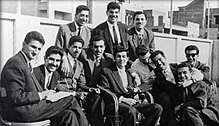
Revolutionary sentiment was characteristic of the era in Iraq and throughout the Middle East. In Iraq progressives and socialists assailed traditional political elites (colonial-era bureaucrats and landowners, wealthy merchants and tribal chiefs, and monarchists).[12] Moreover, the pan-Arab nationalism of Gamal Abdel Nasser in Egypt profoundly influenced young Ba'athists like Saddam. The rise of Nasser foreshadowed a wave of revolutions throughout the Middle East in the 1950s and 1960s, with the collapse of the monarchies of Iraq, Egypt, and Libya.
Nasser inspired nationalists throughout the Middle East by fighting the British and the French during the Suez Crisis of 1956, modernizing Egypt, and uniting the Arab world politically.[13] His father-in-law, Khairallah Talfah, was reported to have served five years in prison for his role in fighting against Great Britain in the 1941 Iraqi coup d'état and Anglo-Iraqi War, and often mentored and told tales of his exploits to the young Saddam.[14] Iraq was under monarchy rule, known as Kingdom of Iraq. In 1958, a year after Saddam had joined the Ba'ath party, army officers led by General Abd al-Karim Qasim overthrew Faisal II of Iraq in the 14 July Revolution.
Rise to power: 1957–1963
[edit]The Ba'ath Party was originally represented in Qasim's cabinet; however, Qasim—reluctant to join Nasser's newly formed union between Egypt and Syria—sided with various groups within Iraq (notably the social democrats and the Iraqi Communist Party) that told him such an action would be dangerous. Instead, Qasim adopted a wataniyah policy of "Iraq First".[15][16] To strengthen his own position within the government, Qasim also had an alliance with the Iraqi Communist Party, which was opposed to the notion of pan-Arabism.[17] His policies angered several pan-Arab organisations, including the Ba'ath Party, which later began plotting to assassinate Qasim at Al-Rashid Street on 7 October 1959 and take power. Saddam was recruited to the assassination conspiracy by its ring-leader, Abdul Karim al-Shaikhly, after one of the would-be assassins left.[18] During the ambush, Saddam (who was only supposed to provide cover) began shooting prematurely, which disorganised the whole operation. Qasim's chauffeur was killed and Qasim was hit in the arm and shoulder. The assassins thought they had killed Qasim and quickly retreated to their headquarters, but Qasim survived.[18] Saddam himself is not believed to have received any training outside of Iraq, as he was a late addition to the assassination team.[19]
Richard Sale of United Press International (UPI), citing former U.S. diplomat and intelligence officials, Adel Darwish, and other experts, reported that the unsuccessful assassination attempt on Qasim was a collaboration between the United States Central Intelligence Agency (CIA) and Egyptian intelligence.[20] Pertinent contemporary records relating to CIA operations in Iraq have remained classified or heavily redacted, thus "allow[ing] for plausible deniability."[21] It is generally accepted that Egypt, in some capacity, was involved in the assassination attempt, and that "[t]he United States was working with Nasser on some level."[22] Sale and Darwish's account has been disputed by historian Bryan R. Gibson who concludes that available U.S. declassified documents show that "while the United States was aware of several plots against Qasim, it had still adhered to [a] nonintervention policy."[23] On the other hand, historian Kenneth Osgood writes that "the circumstantial evidence is such that the possibility of US–UAR collaboration with Ba'ath Party activists cannot be ruled out," concluding that "[w]hatever the validity of [Sale's] charges, at the very least currently declassified documents reveal that US officials were actively considering various plots against Qasim and that the CIA was building up assets for covert operations in Iraq."[22]
At the time of the attack, the Ba'ath Party had fewer than 1,000 members,[24] however the failed assassination attempt led to widespread exposure for Saddam and the Ba'ath within Iraq, where both had previously languished in obscurity, and later became a crucial part of Saddam's public image during his tenure as president of Iraq.[25][26] Kanan Makiya recounts that in this episode, his biography—and Iraqi television, the man and the myth converge as his biography and Iraqi television repeatedly depict his early exposure to guns, his unwavering loyalty and fearlessness during the 1959 operation, his brave acts of rescuing comrades at gunpoint, the removal of a bullet from his own flesh while in hiding, his strict discipline in protecting the wounded, his cleverness in evading capture moments before the police arrived, and his arduous journey across houses, cities, and the desert to seek refuge in Syria.[27]
Michel Aflaq, the leader of the Ba'athist movement, organized the expulsion of leading Iraqi Ba'athist members, such as Fuad al-Rikabi, on the grounds that the party should not have initiated the attempt on Qasim's life. At the same time, Aflaq secured seats in the Iraqi Ba'ath leadership for his supporters, one of them being Saddam.[28] The assassins, including Saddam, all eventually escaped to Cairo, Egypt "where they enjoyed Nasser's protection for the remainder of Qasim's tenure in power."[29] Saddam initially escaped to Syria and then to Egypt itself in February 1960, and he continued to live there until 1963, graduating from high school in 1961 and unsuccessfully pursuing a law degree[30] at Cairo Law School (1962–1963).[31] It is possible that Saddam visited the U.S. embassy in Cairo during his exile,[32] and some evidence suggests that he was "in frequent contact with US officials and intelligence agents."[33] A former high-ranking U.S. official told historians Marion Farouk–Sluglett and Peter Sluglett that Iraqi Ba'athists, including Saddam, "had made contact with the American authorities in the late 1950s and early 1960s."[34]
1963 Coup d'état and arrest
[edit]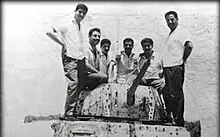
Army officers with ties to the Ba'ath Party overthrew Qasim in the Ramadan Revolution coup of February 1963; long suspected to be supported by the CIA,[35][36] however pertinent contemporary documents relating to the CIA's operations in Iraq have remained classified by the U.S. government,[37][38] although the Ba'athists are documented to have maintained supportive relationships with U.S. officials before, during, and after the coup.[39][40] Ba'athist leaders were appointed to the cabinet and Abdul Salam Arif became president. Arif dismissed and arrested the Ba'athist leaders later that year in the November 1963 Iraqi coup d'état. Being exiled in Egypt at the time, Saddam played no role in the 1963 coup or the brutal anti-communist purge that followed; although he returned to Iraq after the coup, becoming a key organizer within the Ba'ath Party's civilian wing upon his return.[41]
Unlike during the Qasim years, Saddam remained in Iraq following Arif's anti-Ba'athist purge in November 1963, and became involved in planning to assassinate Arif. In marked contrast to Qasim, Saddam knew that he faced no death penalty from Arif's government and knowingly accepted the risk of being arrested rather than fleeing to Syria again. Saddam was arrested in October 1964 and served approximately two years in prison before escaping in 1966.[42] In 1966, Ahmed Hassan al-Bakr appointed him Deputy Secretary of the Regional Command. Saddam, who would prove to be a skilled organizer, revitalized the party.[43] He was elected to the Regional Command, as the story goes, with help from Michel Aflaq—the founder of Ba'athist thought.[44] In September 1966, Saddam initiated an extraordinary challenge to Syrian domination of the Ba'ath Party in response to the Marxist takeover of the Syrian Ba'ath earlier that year, resulting in the Party's formalized split into two separate factions.[45] Saddam then created a Ba'athist security service, which he alone controlled.[46]
Ba'athist Revolution
[edit]n July 1968, Saddam participated in a bloodless coup led by Ahmed Hassan al-Bakr that overthrew Abdul Rahman Arif,[47]: 174 Salam Arif's brother and successor. While Saddam's role in the coup was not hugely significant (except in the official account), Saddam planned and carried out the subsequent purge of the non-Ba'athist faction led by Prime Minister Abd ar-Razzaq an-Naif, whose support had been essential to the coup's success.[48] According to a semi-official biography, Saddam personally led Naif at gunpoint to the plane that escorted him out of Iraq.[49] Arif was given refuge in London and then Istanbul.
Al-Bakr was named president and Saddam was named his deputy, and deputy chairman of the Ba'athist Revolutionary Command Council. According to biographers, Saddam never forgot the tensions within the first Ba'athist government, which formed the basis for his measures to promote Ba'ath party unity as well as his resolve to maintain power and programs to ensure social stability. Although Saddam was al-Bakr's deputy, he was a strong behind-the-scenes party politician. Al-Bakr was the older and more prestigious of the two, but by 1969 Saddam clearly had become the moving force behind the party.
Vice Presidency: 1968–1979
[edit]Political program
[edit]In the late 1960s and early 1970s, as vice chairman of the Revolutionary Command Council, formally al-Bakr's second-in-command, Saddam built a reputation as a progressive, effective politician.[50] At this time, Saddam moved up the ranks in the new government by aiding attempts to strengthen and unify the Ba'ath party and taking a leading role in addressing the country's major domestic problems and expanding the party's following.
After the Ba'athists took power in 1968, Saddam focused on attaining stability in a nation riddled with profound tensions. Long before Saddam, Iraq had been split along social, ethnic, religious, and economic fault lines: Sunni versus Shi'ite, Arab versus Kurd, tribal chief versus urban merchant, nomad versus peasant.[51] The desire for stable rule in a country rife with factionalism led Saddam to pursue both massive repression and the improvement of living standards.[51]
Kurdish autonomy
[edit]
Although his position on Kurdish politics has been debated, Saddam Hussein has allowed autonomy for the Kurds to an extent,[52] with Kurds being allowed to speak Kurdish in schools, on television, and even in newspapers, with textbooks being translated for the Kurdish regions, and Kurds in Iraq being able to elect a Kurdish representative to go to Baghdad.[53] Saddam Hussein had already signed a deal in 1970 to grant the Kurds autonomy, but Mustafa Barazani eventually disagreed with the deal, which incited the Second Iraqi–Kurdish War.
Infrastructure and Education
[edit]Under Saddam's regime, substantial reforms in education and literacy took place, with Saddam Hussein introducing mandatory reading groups for adults, with punishments for not attending consisting of heavy fines, and even jail time. The regime also mandated education for primary to high school, with Saddam's regime also mandating free tuition for university students. Estimates being that in 1979 alone, over 2 million Iraqi adults were studying in more than 28,735 literacy schools, with over 75,000 teachers.
Within just a few years, Iraq was providing social services that were unprecedented among Middle Eastern countries. Saddam established and controlled the "National Campaign for the Eradication of Illiteracy" and the campaign for "Compulsory Free Education in Iraq", and largely under his auspices, the government established universal free schooling up to the highest education levels; hundreds of thousands learned to read in the years following the initiation of the program. The government also supported families of soldiers, granted free hospitalization to everyone, and gave subsidies to farmers. Iraq created one of the most modernized public-health systems in the Middle East, earning Saddam an award from the United Nations Educational, Scientific and Cultural Organization (UNESCO).[54][55]
Socioeconomic reforms
[edit]The oil revenue benefited Saddam politically.[56] According to The Economist, "Much as Adolf Hitler won early praise for galvanizing German industry, ending mass unemployment and building autobahns, Saddam earned admiration abroad for his deeds. At the center of this strategy was Iraq's oil. On 1 June 1972, Saddam oversaw the seizure of international oil interests, which, at the time, dominated the country's oil sector. A year later, world oil prices rose dramatically as a result of the 1973 energy crisis, and skyrocketing revenues enabled Saddam to expand his agenda. With the help of increasing oil revenues, Saddam diversified the largely oil-based Iraqi economy.He nationalised independent banks, eventually leaving the banking system insolvent due to inflation and bad loans.[57]
Saddam focused on fostering loyalty to the Ba'athists in the rural areas. After nationalizing foreign oil interests, Saddam supervised the modernization of the countryside, mechanizing agriculture on a large scale, and distributing land to peasant farmers.[58] The Ba'athists established farm cooperatives and the government also doubled expenditures for agricultural development in 1974–1975. Saddam's welfare programs were part of a combination of "carrot and stick" tactics to enhance support for Saddam. The state-owned banks were put under his thumb. Lending was based on cronyism.[59]
Second Kurdish War: 1974–1975
[edit]Foreign affairs
[edit]In 1972, Saddam signed a 15-year Treaty of Friendship and Cooperation with the Soviet Union. According to historian Charles R. H. Tripp, the treaty upset "the US-sponsored security system established as part of the Cold War in the Middle East. It appeared that any enemy of the Baghdad regime was a potential ally of the United States."[60] In response, the US covertly financed Kurdish rebels led by Mustafa Barzani during the Second Iraqi–Kurdish War; the Kurds were defeated in 1975, leading to the forcible relocation of hundreds of thousands of Kurdish civilians.[60]
After the oil crisis of 1973, France had changed to a more pro-Arab policy and was accordingly rewarded by Saddam with closer ties. He made a state visit to France in 1975, cementing close ties with some French business and ruling political circles. In 1975 Saddam negotiated an accord with Iran that contained Iraqi concessions on border disputes. In return, Iran agreed to stop supporting opposition Kurds in Iraq. Saddam led Arab opposition to the Camp David Accords between Egypt and Israel (1979).
Yom Kippur War
[edit]Vietnam War
[edit]Presidency: 1979–2003
[edit]Domestic policy
[edit]Economic reforms
[edit]By the late 1970s, Iraq experienced significant economic growth, with a budget reserve surpassing US$35 billion. The value of 1 Iraqi dinar was worth more than 3 dollars, making it one of the most notable economic expansions in the region. Saddam Hussein's regime aimed to diversify the Iraqi economy beyond oil. The government invested in various industries, including petrochemicals, fertilizer production, and textile manufacturing, to reduce dependence on oil revenues and promote economic self-sufficiency.[61] By the 1970s, women employment rate also increased.
Following the invasion of Kuwait which initiated the Gulf War, Iraq was sanctioned by the UN, which caused economic decline. In 1995, then U.S. president Bill Clinton introduced Oil-for-Food Programme. It's objective was to allow Iraq sell oil in exchange for humanitarian needs for ordinary Iraqi citizens without allowing Iraqi government to boost its military capabilities. By the late 1990s, economic situation showed improvement. The program was accepted by the Ba'athist government in 1996.[62] By 1995, GDP of Iraq dropped to US$9 billion from US$44.36 billion in 1990. Iraq had lost around US$170 billion of oil revenues. The economy of Iraq improved in 2000, as its GDP increased to U$23.73 billion by 2000.[63]
Freedom of religion
[edit]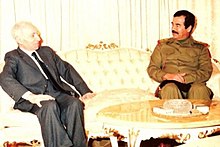
Iraq under Saddam Hussein was known for religious tolerance, as different religious minorities coexisted peacefully. The Ba'athist government led by Saddam Hussein was a secular based. His government was noted for granting freedom of worship to all religions. In the Persian Gulf, Iraq was the only secular country and granted freedom of worship to people of all religions. Involvement of Iraq in wars during Saddam caused persecution of these community, specially during the Iraq War, many of the Christians and Jews of Iraq fled. Saddam led a secular progressive regime that kept the Wahhabi and Salafi extremist ideology of Al-Qaeda from taking root in the country. The country was free of any sectarian violence or civil disorder. The Ba'athist ideology followed by Saddam, was founded by Michel Aflaq, who was a Syrian Christian.
During his tenure, more than 1.2 million Christians lived in Iraq, highlighting the country's diverse religious landscape. Tariq Aziz, who was a Chaldean, held various political positions in the Ba'athist government, a friend of him and was a close advisor to Saddam Hussein. Due to close relations with Chaldeans, Saddam donated heavy amount to Chaldean churches and institutions across the United States, despite having hostile relations. After fall of his government in 2003, Christians in Iraq faced persecution.
During Saddam Hussein's rule, the Jews were treated fairly. They were among the various religious minority groups in the country and had the freedom to practice their religion. Saddam's government restored the Meir Taweig Synagogue and Baghdad's Jewish cemetery. An incident took place on 4 October 1998, when a Palestinian man opened fire, killing four people including two Jews. Following the arrest of Palestinian perpetrator, the government pledged to ensure prompt justice. As a precautionary measure, police guards were stationed at the synagogue, and the Iraqi Cabinet released a statement denouncing the shooting incident. The Cabinet emphasized that the Jewish community in Iraq are Iraqis that should not be associated with Zionist activities aimed at disrupting the political, economic, social, and health security of Arab countries. Several Jewish sites, including synagogues, cemeteries and the Ezekiel's Tomb, were protected by Ba'ath security forces.
Saddam was recognized for safeguarding the Mandaean minority in Iraq.[64] Mandaeans being given state protection under Saddam. He also vowed to construct temples for the Mandaeans, with Saddam quoting "Iraqis have religious freedom, whether they are Muslims, Christians or Sabaeans",[65] Mandaeans were some of the best goldsmiths and jewelers in Iraq, with Saddam's personal jeweler being of Mandaean background.[66] However, after his regime's downfall, Mandaeans faced severe persecution, and constant kidnappings, and often expressed that they were better under Saddam's rule.[66]
Women's rights
[edit]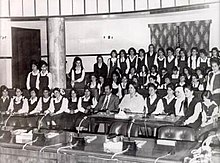
Saddam also took steps to promote women's rights within Iraq. By the late 1970s, women in Iraq held significant roles in society, representing 46% of all teachers, 29% of all doctors, 46% of all dentist and 70% of all pharmacists. These advancements signaled progress in women's participation in various professional fields.[citation needed] Women also saw drastic increase in rights in other-aspects of life, with women being given equal-rights in marriage, divorce, inheritance, and custody.[67] Women in Iraq also had the ability to pass their citizenship down to their children even if they married a non-Iraqi, which Iraqi women no longer have the ability to do. Women's education no longer was a luxury, with women having the same opportunities as men in higher education.[67]
Saddam also introduced social security programs, with the notable parts of the program consisting of disability benefits, with disabled people in Iraq becoming eligible for financial assistance.[68] It also introduced healthcare coverage, ensuring Iraqi citizens had access to healthcare and medication when needed,[69] Although during the 90's Iraqi-healthcare decreased in its effectiveness with the sanctions restricting basic-medical equipment and supplies from getting into Iraq.[70]
Iran–Iraq War: 1980–1988
[edit]In early 1979, Iran's Shah Mohammad Reza Pahlavi and Pahlavi dynasty were overthrown by the Islamic Revolution, thus giving way to an Islamic republic led by the Ayatollah Ruhollah Khomeini. The influence of revolutionary Shi'ite Islam grew apace in the region, particularly in countries with large Shi'ite populations, especially Iraq. Saddam feared that radical Islamic ideas—hostile to his secular rule—were rapidly spreading inside his country among the majority Shi'ite population. Despite Saddam's fears of massive unrest, Iran's attempts to export its Islamic Revolution were largely unsuccessful in rallying support from Shi'ites in Iraq and the Gulf states. Most Iraqi Shi'ites, who comprised the majority of the Iraqi Armed Forces, chose their own country over their Shi'ite Iranian coreligionists during the Iran–Iraq War that ensued.

There had also been bitter enmity between Saddam and Khomeini since the 1970s. Khomeini, having been exiled from Iran in 1964, took up residence in Iraq, at the Shi'ite holy city of Najaf. There he involved himself with Iraqi Shi'ites and developed a strong religious and political following against the Iranian Government, which Saddam tolerated. When Khomeini began to urge the Shi'ites there to overthrow Saddam and under pressure from the Shah, who had agreed to a rapprochement between Iraq and Iran in 1975, Saddam agreed to expel Khomeini in 1978 to France. Here, Khomeini gained media connections and collaborated with a much larger Iranian community, to his advantage. After Khomeini gained power, skirmishes between Iraq and revolutionary Iran occurred for ten months over the sovereignty of the disputed Shatt al-Arab waterway, which divides the two countries. During this period, Saddam publicly maintained that it was in Iraq's interest not to engage with Iran, and that it was in the interests of both nations to maintain peaceful relations. In a private meeting with Salah Omar al-Ali, Iraq's permanent ambassador to the United Nations, he revealed that he intended to invade and occupy a large part of Iran within months.
Iraq invaded Iran on 22 September 1980, first launching airstrikes on numerous targets in Iran, including the Mehrabad Airport of Tehran, before occupying the oil-rich Iranian province of Khuzestan, which also has a sizable Arab minority. The invasion was initially successful, as Iraq captured more than 25,900 km2 of Iranian territory by 5 December 1980. With the support of other Arab states, the United States, and Europe, and heavily financed by the Arab states of the Persian Gulf, Saddam had become "the defender of the Arab world" against a revolutionary, fundamentalist and Shia Islamist Iran. The only exception was the Soviet Union, which initially refused to supply Iraq on the basis of neutrality in the conflict, although in his memoirs, Mikhail Gorbachev claimed that Leonid Brezhnev refused to aid Saddam over infuriation of Saddam's treatment of Iraqi communists. Consequently, many viewed Iraq as "an agent of the civilized world." The blatant disregard of international law and violations of international borders were ignored. Instead Iraq received economic and military support from its allies, who overlooked Saddam's use of chemical warfare against the Kurds and the Iranians, in addition to Iraq's efforts to develop nuclear weapons. In the first days of the war, there was heavy ground fighting around strategic ports as Iraq launched an attack on Khuzestan. After making some initial gains, Iraq's troops began to suffer losses from human wave attacks by Iran. By 1982, Iraq was on the defensive and looking for ways to end the war.[71]
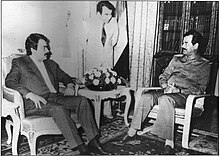
Iraq quickly found itself bogged down in one of the longest and most destructive wars of attrition of the 20th century.[72] During the war, Iraq used chemical weapons against Iranian forces fighting on the southern front and Kurdish separatists who were attempting to open up a northern front in Iraq with the help of Iran.[72] Iraqi Foreign Minister Tariq Aziz later acknowledged Iraq's use of chemical weapons against Iran, but said that Iran had used them against Iraq first.[73] These chemical weapons were developed by Iraq from materials and technology supplied primarily by West German companies as well as using dual-use technology imported following the Reagan administration's lifting of export restrictions.[74] The US government also supplied Iraq with "satellite photos showing Iranian deployments.",[75] which were later deemed to be misleading intelligence information designed to prolong the war with Iran and increase US influence in the region, contributing to the Iraqi defeat in the First Battle of al-Faw in February 1986.[76] In a US bid to open full diplomatic relations with Iraq, the country was removed from the US list of State Sponsors of Terrorism in February 1982.[77] Ostensibly, this was because of improvement in the regime's record, although former US Assistant Secretary of Defense Noel Koch later stated, "No one had any doubts about [the Iraqis'] continued involvement in terrorism ... The real reason was to help them succeed in the war against Iran."[78] The Soviet Union, France, and China together accounted for over 90% of the value of Iraq's arms imports between 1980 and 1988.[79] While the United States supplied Iraq with arms, dual-use technology and economic aid, it was also involved in a covert and illegal arms deal, providing sanctioned Iran with weaponry. This political scandal became known as the Iran–Contra affair.[80] Saddam reached out to other Arab governments for cash and political support during the war, particularly after Iraq's oil industry severely suffered at the hands of the Iranian navy in the Persian Gulf. Iraq successfully gained some military and financial aid, as well as diplomatic and moral support, from the Soviet Union, China, France, and the US, which together feared the prospects of the expansion of revolutionary Iran's influence in the region. The Iranians, demanding that the international community should force Iraq to pay war reparations to Iran, refused any suggestions for a cease-fire. Despite several calls for a ceasefire by the United Nations Security Council, hostilities continued until 20 August 1988.
The bloody eight-year war ended in a stalemate. Encyclopædia Britannica states: "Estimates of total casualties range from 1,000,000 to twice that number. The number killed on both sides was perhaps 500,000, with Iran suffering the greatest losses." Neither side had achieved what they had originally desired and the borders were left nearly unchanged. The southern, oil rich and prosperous Khuzestan and Basra area (the main focus of the war, and the primary source of their economies) were almost completely destroyed and were left at the pre-1979 border, while Iran managed to make some small gains on its borders in the Northern Kurdish area. Both economies, previously healthy and expanding, were left in ruins. Saddam borrowed tens of billions of dollars from other Arab states and a few billions from elsewhere during the 1980s to fight Iran, mainly to prevent the expansion of Shi'a radicalism. This backfired on Iraq and the Arab states, for Khomeini was widely perceived as a hero for managing to defend Iran and maintain the war with little foreign support against the heavily backed Iraq and only managed to boost Islamic radicalism not only within the Arab states, but within Iraq itself, creating new tensions between the Sunni Ba'ath Party and the majority Shi'a population. Faced with rebuilding Iraq's infrastructure and internal resistance, Saddam desperately re-sought cash, this time for postwar reconstruction.
Anfal Campaign: 1986–1989
[edit]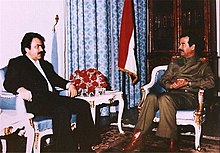
The Anfal campaign was a genocidal campaign that took place during the Iran–Iraq War against the Kurdish people (and many others) in Kurdish regions of Iraq led by the government of Saddam Hussein and headed by Ali Hassan al-Majid. The campaign takes its name from Qur'anic chapter 8 (al-ʾanfāl), which was used as a code name by the former Iraqi Ba'athist administration for a series of attacks against the peshmerga rebels and the mostly Kurdish civilian population of rural Northern Iraq, conducted between 1986 and 1989 culminating in 1988. This campaign also targeted Shabaks and Yazidis, Assyrians, Turkoman people and many villages belonging to these ethnic groups were also destroyed. Human Rights Watch estimates that between 50,000 and 100,000 people were killed. Some Kurdish sources put the number higher, estimating that 182,000 Kurds were killed.
On 16 March 1988, the Kurdish town of Halabja was attacked with a mix of mustard gas and nerve agents during the Halabja massacre, killing between 3,200 and 5,000 people, and injuring 7,000 to 10,000 more, mostly civilians. The attack occurred in conjunction with the Anfal campaign designed to reassert central control of the mostly Kurdish population of areas of northern Iraq and defeat the Kurdish peshmerga rebel forces. Following the incident, The U.S. State Department took the official position that Iran was partly to blame for the Halabja massacre. A study by the Defense Intelligence Agency held Iran responsible for the attack. This assessment was subsequently used by the Central Intelligence Agency for much of the early 1990s. Despite this, few observers today doubt that it was Iraq that executed the Halabja massacre.
After capture, when Saddam and his people were on trial, they denied that they were intended to target Kurdish civilians. During Saddam Hussein's trial for the Anfal campaign, two co-defendants, Sultan Hashim al-Tai and Sabir al-Douri, presented their explanations to the court. They argued that the Iraqi military did not intentionally target Kurdish civilians but instead focused on Iranian troops and Kurdish rebels who were fighting alongside them. Al-Tai, the commander of the Anfal task force, emphasized that their objective was to combat an organized armed army, not civilians. Al-Douri, the director of military intelligence, claimed that their actions were necessary to clear northern Iraq of Iranian troops and to protect Baghdad from potential flooding if nearby dams were destroyed. Both defendants asserted that civilians in the Anfal region had been relocated to safe areas, including the city of Kirkuk. They maintained that they acted in defense of their country and denied any guilt, stating that they implemented their orders precisely and sincerely without turning a blind eye to any violations.
Tensions with Kuwait: 1988–1990
[edit]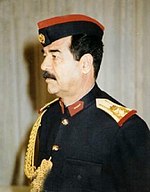
Kuwait was forcefully separated from Iraqi province of Basra and remained as British Protectorate until 1960, when it was officially granted independence. During the 1980–1988 war, Saudi Arabia and Kuwait financially supported Saddam. The end of the war with Iran heightened tensions between Iraq and Kuwait. Saddam demanded that Kuwait waive Iraq's $30 billion war debt, but they refused.[81] Disputes over oil production and prices further strained relations, as Kuwait refused to cut production, keeping prices low while Iraq needed high prices to repay its debt.[82] Saddam claimed that Kuwait was historically part of Iraq, fueling nationalist sentiments.[83] The significant oil reserves in both countries added to the tensions.[84] Saddam deployed troops to the Iraq-Kuwait border.[85]
As tensions escalated between Iraq and Kuwait, Saddam Hussein received conflicting information about how the US would respond to a potential invasion.[86] The US had previously cultivated a relationship with Iraq, providing significant assistance, including financial aid.[87] In April 1990, Saddam threatened to use chemical weapons against Israel if it took action against Iraq.[88] He also criticized US support for Israel and warned against policies that undermined Arab interests.[89] In response, the US deployed warplanes and combat ships to the Persian Gulf.[90]
During an emergency meeting on July 25, 1990, between the US ambassador to Iraq, April Glaspie, and Saddam , tensions were high.[91] He criticized American policy towards Kuwait and the UAE, expressing concerns about their disregard for Iraq's rights.[92] He also warned that Iraq could cause harm if pressured. Glaspie, in response, acknowledged Iraq's need for funds and expressed a lack of opinion on Arab-Arab conflicts.[93] However, she expressed concern about Iraq's deployment of troops and perceived aggression towards Kuwait.[94][95] Saddam mentioned attempting negotiations with Kuwait but emphasized that Iraq would not accept defeat.[96] US officials tried to maintain a conciliatory approach with Iraq, expressing a desire to avoid the use of force but refraining from taking a position on the Iraq-Kuwait boundary dispute. However, Saddam's troops invaded Kuwait after failed negotiations. As tensions escalated, the Soviet Union, led by Mikhail Gorbachev, strengthened its military relationship with Saddam, providing military advisers, arms, and aid.
Gulf War: 1990–1991
[edit]On August 2, 1990, Saddam invaded Kuwait, sparking an international crisis.[97] He initially claimed assistance to "Kuwaiti revolutionaries".[98][97][99] On August 4, an Iraqi-backed "the Provisional Government of Free Kuwait" was proclaimed, but lacked legitimacy and support.[100] This led to an announcement of a "merger" between the two countries on August 8.[101] Kuwait formally became the 19th Governorate of Iraq on August 28, following the invasion. Saddam's actions occurred just two years after the 1988 Iraq and Iran truce.[99] He overran Kuwait, confronting his Gulf neighbors in the name of Arab nationalism and Islam.[102] When asked why he invaded Kuwait, Saddam first claimed it was Iraq's rightful 19th province. Later, he stated, "When I get something into my head I act. That's just the way I am".[103] Saddam had the means to pursue military aggression due to the funds poured into Iraq by Kuwait and the Gulf states. He also had access to weapons and technology provided by the Soviet Union, Germany, and France.[104]

In addition to economic disputes, an insulting exchange between the Kuwaiti emir and the Iraqi foreign minister played a decisive role in triggering the invasion.[105] Saddam claimed that the emir stated his intention to ruin Iraq financially, turning "every Iraqi woman into a $10 prostitute".[106] Before the invasion, Saddam shipped 100 new Mercedes 200 Series cars to top editors in Egypt and Jordan.[107] He reportedly offered Egypt's President Hosni Mubarak 50 million dollars in cash, ostensibly for grain, just two days before the attacks.[108] US President George H. W. Bush responded cautiously initially, considering Kuwait's previous hostility towards Israel and its friendly relations with the Soviets.[109][110] However, concerns about stability in the region, the world economy, and British interests influenced his stance.[111] Cooperation between the US and the Soviet Union led to the passage of UN resolutions setting a deadline for Iraq to leave Kuwait.[112] The fear of Iraqi retaliation against Saudi Arabia, a key US ally, prompted a deployment of troops along the Saudi border with Kuwait and Iraq.[113] During the invasion, Saddam's officers looted Kuwait, even taking the marble from its palaces for Saddam's personal use.[114]
During the period of negotiations and threats following the invasion, Saddam focused renewed attention on the Palestinian problem by promising to withdraw his forces from Kuwait, if Israel would relinquish the occupied territories in the West Bank, the Golan Heights, and the Gaza Strip.[115] Saddam's proposal further split the Arab world, pitting US- and Western-supported Arab states against the Palestinians.[115] The allies ultimately rejected any linkage between the Kuwait crisis and Palestinian issues.[115] In 1991, Saddam ordered firing of scud missiles towards Israel.[115] Later Saddam agreed to pay US$74 million in compensate to Israel, which was borrowed from the amount of oil-for-food program.[115][116][117] During the war, missiles were also fired in cities of Saudi Arabia.[115]
Saddam Hussein ignored the Security Council deadline, leading to a US-led coalition launching missile and aerial attacks on Iraq starting on January 16, 1991.[118] Israel refrained from retaliating to maintain the coalition.[119] The coalition's ground forces, primarily US and British divisions, expelled Saddam's army from Kuwait in February 1991 and occupied southern Iraq.[120] On March 6, 1991, President Bush announced the vision of a "new world order" where diverse nations unite for peace, security, freedom, and the rule of law.[121] The Iraqi army was unable to match the coalition's superior forces and air support. Thousands of Iraqis were taken prisoner, and casualties exceeded 85,000. As part of the cease-fire agreement, Iraq agreed to dismantle chemical and biological weapons and allow UN inspections. Trade sanctions remained until Iraq fully complied. Saddam publicly claimed victory at the end of the war.[122]
Iraqi Uprisings: 1991–1999
[edit]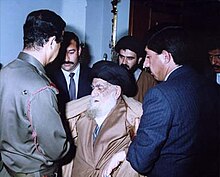
Iraq's ethnic and religious divisions, together with the brutality of the conflict that this had engendered, laid the groundwork for postwar rebellions. In the aftermath of the fighting, social and ethnic unrest among Shi'ite Muslims, Kurds, and dissident military units threatened the stability of Saddam's government. Uprisings erupted in the Kurdish north and Shi'a southern and central parts of Iraq, but were ruthlessly repressed. Uprisings in 1991 led to the death of 100,000–180,000 people, mostly civilians.[123]
Ayatollah al-Khoei, an Iranian-Iraqi Shia marja' was one of the key-figures behind the uprisings. He was forced to visit Saddam after fault riot of al-Dawa political party in 1991. He was put under house arrest by Saddam and died later.
The United States, which had urged Iraqis to rise up against Saddam, did nothing to assist the rebellions. The Iranians, despite the widespread Shi'ite rebellions, had no interest in provoking another war, while Turkey opposed any prospect of Kurdish independence, and the Saudis and other conservative Arab states feared an Iran-style Shi'ite revolution. Saddam, having survived the immediate crisis in the wake of defeat, was left firmly in control of Iraq, although the country never recovered either economically or militarily from the Gulf War.[124]
Assassination of Muhammad al-Sadr cause tensions between Saddam's government and Iraqi Shi'ite.
Faith Campaign
[edit]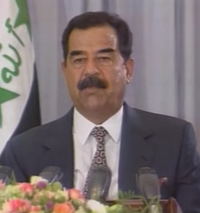
Saddam routinely cited his survival as "proof" that Iraq had in fact won the war against the US. This message earned Saddam a great deal of popularity in many sectors of the Arab world. John Esposito wrote, "Arabs and Muslims were pulled in two directions. That they rallied not so much to Saddam as to the bipolar nature of the confrontation (the West versus the Arab Muslim world) and the issues that Saddam proclaimed: Arab unity, self-sufficiency, and social justice." As a result, Saddam appealed to many people for the same reasons that attracted more and more followers to Islamic revivalism and also for the same reasons that fueled anti-Western feelings.[125]
One US Muslim observer[who?] noted: "People forgot about Saddam's record and concentrated on America ... Saddam Hussein might be wrong, but it is not America who should correct him." A shift was, therefore, clearly visible among many Islamic movements in the post war period "from an initial Islamic ideological rejection of Saddam Hussein, the secular persecutor of Islamic movements, and his invasion of Kuwait to a more populist Arab nationalist, anti-imperialist support for Saddam (or more precisely those issues he represented or championed) and the condemnation of foreign intervention and occupation."[126] Some elements of Sharia law were re-introduced, and the phrase "Allahu Akbar" ("God is great"), in Saddam's handwriting, was added to the national flag. Saddam also commissioned the production of a "Blood Qur'an", written using 27 litres of his own blood, to thank God for saving him from various dangers and conspiracies.[127]
Post-war: 1996–2003
[edit]Saddam proposed secret summit with Syrian president Hafez al-Assad in 1996, discussing Israel's aggression on Lebanon.[128]
In July 1997 Saddam appealed to the United Nations Security Council, to pressurize the United States to lift up the sanctions on Iraq.[129] Saddam also made efforts to improve Iraq's relations with Iran. In 1997 he ordered and released two Iranian prisoners, who were jailed in 1991. His foreign spokesperson also said about Organisation of Islamic Cooperation meeting to be held in Tehran.[130] He appointed Kamal Mustafa Abdullah as commander of Republican Guard.[131]
Final years: 2000–2003
[edit]In August 2000, Venezuelan president Hugo Chávez made a visit to Iraq and met Saddam.[132] He was first leader of a foreign state to visit the country, since the 1990–1991 Gulf War.[133] His meeting with Saddam was criticized by the United States, who is a major importer of Venezuela's oil.[133] During his tour to invite the leaders of the 10 OPEC member states to a summit the following month, Chávez expressed that he had engaged in "fruitful" discussions with Saddam regarding the future role of the Organization of Petroleum Exporting Countries and the defense of reasonable oil prices.[133] Chávez emphasized the significance of bilateral cooperation between their nations in these matters.[133] The discussions between Chávez and Saddam took place in the past, during a period when both leaders were active.[133] Chávez sought to strengthen ties and foster collaboration among OPEC member states, focusing on the organization's future trajectory and the importance of maintaining oil prices at a reasonable level.[133] The aim was to ensure stability and fairness in the global oil market.[133]
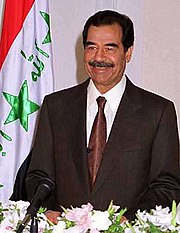
Saddam continued to work on Republican Guard and Fedayeen Saddam, which was supervised by his younger son Qusay Hussein.[134] In October 2000, Saddam was also visited by then Libyan leader Muammar Gaddafi's daughter Ayesha Gaddafi.[135] Saddam later decided to use Euro, instead of Dollars for Iraqi oil.[136] Almost all of Iraq's oil exports under the United Nations oil-for-food program were paid in euros since 2001.[136] Approximately 26 billion euros (£17.4bn) was paid for 3.3 billion barrels of oil into an escrow account in New York.[136] Internally Saddam continued authoritarian way of governance and suppressed political opponents.[137] Between October and November 2000 Saddam led volunteer's campaign in solidarity with the Palestinians during the second intifada.[138] Diplomatic isloation of Iraq with Arab states were disappearing gradually.[139] On 25 April 2001, the British government started investigation on alleged war crimes done by Saddam.[140] On 28 April 2001, Saddam celebrated his birthday, in form of a mega event.[141]
Following month Saddam was chosen as party general secretary at the Baath congress in Baghdad, with every delegate in the hall rising to their feet.[142] However, the Baath's 18-member executive, known as the Iraqi Regional Command, was selected through a secret ballot.[142] The state television reported that 24 candidates stood, and eight new members were elected.[142] Among them was Qusay, Saddam's younger son.[142] Despite holding no high position in the Baath or government, Uday had long been considered the likely successor to his father.[142] This situation resembled Syria, where Bashar al–Assad succeeded his father as president of the country the previous July, despite not previously holding a high position in the party or government.[142] Saddam commenced the Baghdad party meeting with a speech advising the more than 300 delegates on how to vote.[142] After the speech, the elections took place.[142] Another surprise was the election of Huda Saleh Mehdi Ammash, the first woman to win a seat on the party executive.[142] Saddam had recently encouraged women to play a greater role in Iraq.[142] The deputy secretary general of the command, Izzat Ibrahim, was re-elected, and according to the constitution, he would become the interim president in the event of Saddam's sudden death.[142] Among those who lost their executive seats was the deputy prime minister, Mohammed Hamza al-Zubaidi.[142] Russian president Vladimir Putin sent a message to Saddam, promoting diplomatic relations between Iraq and Russia.[143] Saddam also invited Kurds to the negotiation table.[144] A foreign coup d'état was planned to overthrow Saddam, which was later dropped down after three months of September 11 attacks.[145]
In 2002, Austrian prosecutors investigated Saddam government's transactions with Fritz Edlinger that possibly violated Austrian money laundering and embargo regulations.[146] Fritz Edlinger, president of the General Secretary of the Society for Austro-Arab relations (GÖAB) and a former member of Socialist International's Middle East Committee, was an outspoken supporter of Saddam. In 2005, an Austrian journalist revealed that Fritz Edlinger's GÖAB had received $100,000 from an Iraqi front company as well as donations from Austrian companies soliciting business in Iraq.[147] In 2002, a resolution sponsored by the European Union was adopted by the Commission for Human Rights, which stated that there had been no improvement in the human rights crisis in Iraq. The statement condemned Saddam's government for its "systematic, widespread and extremely grave violations of human rights and international humanitarian law." The resolution demanded that Iraq immediately put an end to its "summary and arbitrary executions ... the use of rape as a political tool and all enforced and involuntary disappearances."[148]
Foreign policy
[edit]During the Gulf War
[edit]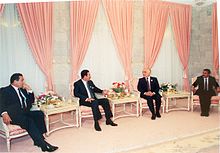
After the Iran–Iraq War Saddam-led Iraq became part of Arab Cooperation Council, along with North Yemen, Egypt and Jordan. Following Iraq's invasion of Kuwait, Saddam was diplomatically isolated by number of countries. The list also included Arab states, such as Egypt, Syria and Saudi Arabia. Egypt left the Arab Cooperation Council. Yemen, Jordan and Palestine maintained their relations with Saddam's government. As a result Jordanians, Yemenis and Palestinians were expelled from Saudi Arabia.
Relations between Syria and Iraq was already tensed, when the former supported Iran in the 1980–1988 war. Syria also sided with the coalition forces against Iraq.
Israel–Palestine conflict
[edit]Saddam was widely known for his pro-Palestinian and anti-Israel stance.[149] He even noticed saying "I will burn Israel". However, his official stance was that relations of Israel with Iraq will be determined by the solution accepted by the Palestinians.[150] During the Iran–Iraq War, the United States supported Iraq and Israel supported Iran. Iran also destroyed a nuclear reactor in 1981. Despite Israel's actions, Saddam reduced his anti–Israel stance.
In 1982, a U.S congressmen visited Saddam.
Second Intifada
[edit]In May 2000, Saddam had secret meetings with the Israeli government, regarding the issues of Palestinian refugees in Lebanon and Iraq.[151][152] Saddam supported the Palestinian uprisings against the Israeli occupation. He also sent a remarkable amount of oil revenues to support Palestinian uprising and victims affected by Israeli aggression. He formed a volunteer force in support of Palestinians, known as the Jerusalem Army. On every occasion, it used to organize rallies across Baghdad and other cities.
Tensions with the United States
[edit]Relations between the US and Iraq remained tense following the Gulf War. The US launched a missile attack aimed at Iraq's intelligence headquarters in Baghdad 26 June 1993, citing evidence of repeated Iraqi violations of the "no fly zones" imposed after the Gulf War and for incursions into Kuwait. US officials continued to accuse Saddam of violating the terms of the Gulf War's cease fire, by developing weapons of mass destruction and other banned weaponry, and violating the UN-imposed sanctions. Also during the 1990s, President Bill Clinton maintained sanctions and ordered air strikes in the "Iraqi no-fly zones" (Operation Desert Fox), in the hope that Saddam would be overthrown by political enemies inside Iraq. Western charges of Iraqi resistance to UN access to suspected weapons were the pretext for crises between 1997 and 1998, culminating in intensive US and British missile strikes on Iraq, 16–19 December 1998. After two years of intermittent activity, US and British warplanes struck harder at sites near Baghdad in February 2001. Former CIA case officer Robert Baer reports that he "tried to assassinate" Saddam in 1995,[153] amid "a decade-long effort to encourage a military coup in Iraq."[154]
Saddam's tensions with the U.S government increased since the Gulf War. The United States supported Iraqi rebels, who wished to overthrow Saddam. In 1996 the U.S Forces conducted an airstrike, in response to Saddam's involvement in the Iraqi Kurdish Civil War. Saddam said that he is interested in a dialogue with the American and demanded a timetable for lifting up the sanctions on Iraq.[155]
On 7 August 2001, the U.S and British aircraft bombed a rocket launcher in northern Iraq and Saddam warned these countries.[156] The September 11 attacks of 2001 shocked the entire world, specially the Muslim world.[157] All Muslim-majority countries condemned the attack. Later Saddam himself replied to an email sent by an American citizen, condemning the attacks and sympathizing with the victim's family.
In the Iraq War: 2003–2006
[edit]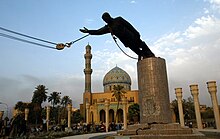
Many members of the international community, especially the US, continued to view Saddam as a bellicose tyrant who was a threat to the stability of the region. In his January 2002 state of the union address to Congress, President George W. Bush spoke of an "axis of evil" consisting of Iran, North Korea, and Iraq. Moreover, Bush announced that he would possibly take action to topple the Iraqi government, because of the threat of its weapons of mass destruction. Bush stated that "The Iraqi regime has plotted to develop anthrax, and nerve gas, and nuclear weapons for over a decade ... Iraq continues to flaunt its hostility toward America and to support terror."[158][159]
After the passing of UNSC Resolution 1441, which demanded that Iraq give "immediate, unconditional and active cooperation" with UN and IAEA inspections,[160] Saddam allowed U.N. weapons inspectors led by Hans Blix to return to Iraq. During the renewed inspections beginning in November 2002, Blix found no stockpiles of WMD and noted the "proactive" but not always "immediate" Iraqi cooperation as called for by Resolution 1441.[161] With war still looming on 24 February 2003, Saddam took part in an interview with CBS News reporter Dan Rather. Talking for more than three hours, he denied possessing any weapons of mass destruction, or any other weapons prohibited by UN guidelines. Saddam also denied of having ties with Al-Qaeda and other groups, known for terror attacks. He also expressed a wish to have a live televised debate with George W. Bush, which was declined. It was his first interview with a US reporter in over a decade.[162] CBS aired the taped interview later that week. Saddam later told an FBI interviewer that he once left open the possibility that Iraq possessed weapons of mass destruction in order to appear strong against Iran.[163][164]
The Iraqi government and military collapsed within three weeks of the beginning of the US-led invasion of Iraq on 20 March 2003, initiating the Iraq War. By the beginning of April, US-led forces occupied much of Iraq. Most of the Ba'athist leaders were either arrested or went in hiding. The resistance of the much-weakened Iraqi Army either crumbled or shifted to guerrilla tactics, and it appeared that Saddam had lost control of Iraq. Huge protests against the coalition forces took place in streets of Baghdad He was last seen in a video which purported to show him in the Baghdad suburbs surrounded by supporters. When Baghdad fell to US-led forces on 9 April, marked symbolically by the toppling of his statue,[165] Saddam was nowhere to be found.
Capture and Interrogation
[edit]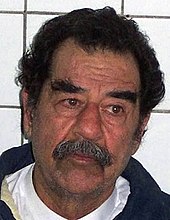
In April 2003, Saddam's whereabouts remained in question during the weeks following the fall of Baghdad and the conclusion of the major fighting of the war. Various sightings of Saddam were reported in the weeks following the war, but none were authenticated. At various times Saddam released audio tapes promoting popular resistance to his ousting. Saddam was placed at the top of the US list of most-wanted Iraqis. In July 2003, his sons Uday and Qusay and 14-year-old grandson Mustapha were killed in a three-hour gunfight with US forces in Mosul.[166][167]
On 13 December 2003, in Operation Red Dawn, Saddam was captured by American forces after being found hiding in a hole in the ground near a farmhouse in ad-Dawr, near Tikrit. Following his capture, Saddam was transported to a US base near Tikrit, and later taken to the American base near Baghdad Airport. Documents obtained and released by the National Security Archive detail FBI interviews and conversations with Saddam while he was in US custody.[168] On 14 December, US administrator in Iraq Paul Bremer confirmed that Saddam had indeed been captured at a farmhouse in ad-Dawr near Tikrit.[169] Bremer presented video footage of Saddam in custody. Saddam was shown with a full beard and hair longer than his familiar appearance. He was described by US officials as being in good health. Bremer reported plans to put Saddam on trial, but claimed that the details of such a trial had not yet been determined. Iraqis and Americans who spoke with Saddam after his capture generally reported that he remained self-assured, describing himself as a "firm, but just leader."[170]
British tabloid newspaper The Sun posted a picture of Saddam wearing white briefs on the front cover of a newspaper. Other photographs inside the paper show Saddam washing his trousers, shuffling, and sleeping. The US government stated that it considered the release of the pictures a violation of the Geneva Convention and that it would investigate the photographs.[171][172] During this period Saddam was interrogated by FBI agent George Piro.[173] The guards at the Baghdad detention facility called their prisoner "Vic", which stands for "Very Important Criminal" and let him plant a small garden near his cell. The nickname and the garden are among the details about the former Iraqi leader that emerged during a March 2008 tour of the Baghdad prison and cell where Saddam slept, bathed, kept a journal, and wrote poetry in the final days before his execution; he was concerned to ensure his legacy and how the history would be told. The tour was conducted by US Marine Maj. Gen. Doug Stone, overseer of detention operations for the US military in Iraq at the time. During his imprisonment he exercised and was allowed to have his personal garden; he also smoked his cigars and wrote his diary in the courtyard of his cell.[174]
Trial by the Iraqi Tribunal
[edit]
On 30 June 2004, Saddam Hussein, held in custody by US forces at the US base "Camp Cropper", along with 11 other senior Ba'athist leaders, was handed over to the interim Iraqi government to stand trial for crimes against humanity and other offences. A few weeks later, he was charged by the Iraqi Special Tribunal with crimes committed against residents of Dujail in 1982, following a failed assassination attempt against him. Specific charges included the murder of 148 people, torture of women and children and the illegal arrest of 399 others.[175][176] There were many challenges in the trial
Saddam and his lawyers contesting the court's authority and maintaining that he was still the President of Iraq.[177] The assassinations and attempted assassinations of several of Saddam's lawyers took place. The replacement of the chief presiding judge happened midway through the trial. On 5 November 2006, Saddam was found guilty of crimes against humanity and sentenced to death by hanging. Saddam's half-brother, Barzan Ibrahim, and Awad Hamed al-Bandar, head of Iraq's Revolutionary Court in 1982, were convicted of similar charges. The verdict and sentencing were both appealed, but subsequently affirmed by Iraq's Supreme Court of Appeals.[178]
Execution
[edit]Saddam was hanged on the first day of Eid ul-Adha, 30 December 2006,[179] despite his wish to be executed by firing squad (which he argued was the lawful military capital punishment, citing his military position as the commander-in-chief of the Iraqi military).[180] The execution was carried out at Camp Justice, an Iraqi army base in Kadhimiya, a neighborhood of northeast Baghdad.
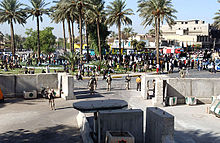
Saudi Arabia condemned Iraqi authorities for carrying on with the execution on a holy day. A presenter from the Al-Ikhbariya television station officially stated: "There is a feeling of surprise and disapproval that the verdict has been applied during the holy months and the first days of Eid al-Adha. Leaders of Islamic countries should show respect for this blessed occasion ... not demean it."[181] Video of the execution was recorded on a mobile phone and his captors could be heard insulting Saddam. The video was leaked to electronic media and posted on the Internet within hours, becoming the subject of global controversy.[182] It was later claimed by the head guard at the tomb where his remains lay that Saddam's body had been stabbed six times after the execution.[183] Saddam's demeanor while being led to the gallows has been discussed by two witnesses, Iraqi Judge Munir Haddad and Iraqi national security adviser Mowaffak al-Rubaie. The accounts of the two witnesses are contradictory as Haddad describes Saddam as being strong in his final moments whereas al-Rubaie says Saddam was clearly afraid.[184]
Saddam's last words during the execution, "May God's blessings be upon Muhammad and his household. And may God hasten their appearance and curse their enemies." Then one of the crowd repeatedly said the name of the Iraqi Shiite cleric, Moqtada Al-Sadr. Saddam laughed and later said, "Do you consider this manhood?" The crowd shouted, "go to Hell." Saddam replied, "To the hell that is Iraq!?" Again, one of the crowd asked those who shouted to keep quiet for God. Saddam Hussein started recitation of final Muslim prayers, "I bear witness that there is no god but Allah and I testify that Muhammad is the Messenger of Allah." One of the crowd shouted, "The tyrant [dictator] has collapsed!" Saddam said, "May God's blessings be upon Muhammad and his household (family)". He recited the shahada one and a half times, as while he was about to say 'Muhammad' on the second shahada, the trapdoor opened, cutting him off mid-sentence. The rope broke his neck, killing him instantly.[185] Not long before the execution, Saddam's lawyers released his last letter.[186] A second unofficial video, apparently showing Saddam's body on a trolley, emerged several days later. It sparked speculation that the execution was carried out incorrectly as Saddam Hussein had a gaping hole in his neck.[187]
Saddam was buried at his birthplace of Al-Awja in Tikrit, Iraq, on 31 December 2006. He was buried 3 km (2 mi) from his sons Uday and Qusay Hussein.[188] His tomb was reported to have been destroyed in March 2015.[189] Before it was destroyed, a Sunni tribal group reportedly removed his body to a secret location, fearful of what might happen.[190]
Philanthropy
[edit]Views
[edit]The political ideas and politics pursued by Saddam Hussein became known as Saddamism. This doctrine was officially endorsed by his government and promoted by the Iraqi daily newspaper Babil owned by his son Uday Hussein.[191]
During his leadership, Saddam promoted the idea of dual nationalism which combines Iraqi nationalism and Arab nationalism, a much broader form of ethnic nationalism which supports Iraqi nationalism and links it to matters that impact Arabs as a whole.[192] Saddam Hussein believed that the recognition of the ancient Mesopotamian origins and heritage of Iraqi Arabs was complementary to supporting Arab nationalism.[192]
In the course of his reign, the Ba'athist regime officially included the historic Kurdish Muslim leader Saladin as a patriotic symbol in Iraq, while Saddam called himself son of the Babylonian King Nebuchadnezzar and had stamped the bricks of ancient Babylon with his name and titles next to him.[193][194] During the Gulf War, Saddam claimed the historic roles of Nebuchadnezzar, Saladin and Gamal Abdel Nasser.[195]
He also conducted two show elections, in 1995 and 2002. In the 1995 referendum, conducted on 15 October, he reportedly received 99.96% of the votes in a 99.47% turnout, getting 3,052 negative votes among an electorate of 8.4 million.[196][197]
In the 15 October 2002 referendum he officially achieved 100% of approval votes and 100% turnout, as the electoral commission reported the next day that every one of the 11,445,638 eligible voters cast a "Yes" vote for the president.[198]
He erected statues around the country, which Iraqis toppled after his fall.[199][200]
Honors and awards
[edit]In 1991, the Iraqi government awarded Saddam the Rafidain medal, also known as Order of the Two Rivers, the country's highest honor, as a recognition of his "historic role" and "noble services to Iraq".[201][202] This announcement was made following a Cabinet meeting, and Information Minister Hamid Youssef Hummadi stated that the decision was unanimous.[201][202] The award was bestowed on Saddam Hussein, during his 54th birthday, in appreciation of his exceptional contributions and significant impact on Iraq.[201]
He was honored by titles such as "Field Marshal" and "Comrade". Saddam Hussein is one of the recipients of the Key to the City.[203][204] In 1980, Saddam Hussein was awarded a key to the city of Detroit after he donated almost half a million dollars to a church in the city.[205] The Ba'ath government led by Saddam Hussein successfully turned Iraq into a leading hub for healthcare and education.[206] This improved quality of life in Iraq.[207] For improving quality of life of Iraqis, Saddam was honored by an award from UNESCO.[208]
Saddam received a number of medals, which were displayed at a museum in Johannesburg, South Africa.[209] He received the Order of Merit (Wisam al-Jadara), which is rare and was awarded to only a few Iraqi rulers.[210] Order of the Mother of Battles was awarded to Saddam Hussein for his role in the 1991 Gulf War against Kuwait and the United States.[211] Saddam received medals for the 1948–'49 Palestinian War, crushing the Kurdish rebellion, the 1963 and 1968 revolutions, cooperation with Syria, peace in 1970, and the 1973 war with Israel.[212]
Legacy
[edit]Personal life
[edit]Family
[edit]Lifestyle
[edit]- ^ Con Coughlin, Saddam: The Secret Life Pan Books, 2003 (ISBN 978-0-330-39310-2).
- ^ "جريدة الرياض | أحمد حسن البكر رجل المقاومة الأول ضد بريطانيا". 2020-09-23. Archived from the original on 23 September 2020. Retrieved 2023-05-23.
- ^ Baram, Amatzia (8 July 2003). "The Iraqi Tribes and the Post-Saddam System". Brookings. Retrieved 2023-05-23.
- ^ "Not mad, just bad and dangerous". The Sydney Morning Herald. 2002-11-16. Retrieved 2024-02-17.
- ^ Bumiller, Elisabeth (15 May 2004). "Was a Tyrant Prefigured by Baby Saddam?". The New York Times. ISSN 1553-8095. OCLC 1645522. Archived from the original on 11 September 2016. Retrieved 21 November 2018.
- ^ Jack, Anderson. "Saddam's Roots an Abusive Childhood". The Washington Post. Retrieved 8 November 2021.
- ^ Post, Jerrold. "Saddam is Iraq: Iraq is Saddam" (PDF). Maxwell Airforce Base. Archived (PDF) from the original on 21 May 2021. Retrieved 20 November 2021.
- ^ a b Karsh, Efraim; Rautsi, Inari (2002). Saddam Hussein: A Political Biography. Grove Press. pp. 13–15. ISBN 978-0-8021-3978-8.
- ^ Eric Davis, Memories of State: Politics, History, and Collective Identity in Modern Iraq, University of California Press, 2005.
- ^ Batatu, Hanna (1979). The Old Social Classes & The Revolutionary Movement in Iraq. Princeton University Press. ISBN 978-0-691-05241-0.
- ^ Karsh, Efraim; Rautsi, Inari (2002). Saddam Hussein: A Political Biography. Grove Press. pp. 13–15. ISBN 978-0-8021-3978-8.
- ^ R. Stephen Humphreys, Between Memory and Desire: The Middle East in a Troubled Age, University of California Press, 1999, p. 68.
- ^ Humphreys, 68
- ^ Post, Jerrold. "Saddam is Iraq: Iraq is Saddam" (PDF). Maxwell Airforce Base. Archived (PDF) from the original on 21 May 2021. Retrieved 20 November 2021.
- ^ Polk, William Roe (2005). Understanding Iraq. I.B. Tauris. p. 111. ISBN 978-0857717641.
- ^ Simons, Geoff (1996). Iraq: From Sumer to Saddam. St. Martin's Press. p. 221. ISBN 978-0312160524.
- ^ Coughlin 2005, pp. 25–26.
- ^ a b Coughlin 2005, p. 29.
- ^ Osgood, Kenneth (2009). "Eisenhower and regime change in Iraq: the United States and the Iraqi Revolution of 1958". America and Iraq: Policy-making, Intervention and Regional Politics. Routledge. p. 22. ISBN 978-1-134-03672-1.
- ^ Sale, Richard (April 10, 2003). "Exclusive: Saddam Key in Early CIA Plot". United Press International. Retrieved April 2, 2018.
- ^ Osgood, Kenneth (2009). "Eisenhower and regime change in Iraq: the United States and the Iraqi Revolution of 1958". America and Iraq: Policy-making, Intervention and Regional Politics. Routledge. p. 16. ISBN 9781134036721.
The documentary record is filled with holes. A remarkable volume of material remains classified, and those records that are available are obscured by redactions – large blacked-out sections that allow for plausible deniability. While it is difficult to know exactly what actions were taken to destabilize or overthrow Qasim's regime, we can discern fairly clearly what was on the planning table. We also can see clues as to what was authorized.
- ^ a b Osgood, Kenneth (2009). "Eisenhower and regime change in Iraq: the United States and the Iraqi Revolution of 1958". America and Iraq: Policy-making, Intervention and Regional Politics. Routledge. pp. 21–23. ISBN 9781134036721.
- ^ Gibson, Bryan R. (2015). Sold Out? US Foreign Policy, Iraq, the Kurds, and the Cold War. Palgrave Macmillan. pp. 25–26. ISBN 978-1-137-48711-7.
- ^ Coughlin 2005, p. 30.
- ^ Osgood, Kenneth (2009). "Eisenhower and regime change in Iraq: the United States and the Iraqi Revolution of 1958". America and Iraq: Policy-making, Intervention and Regional Politics. Routledge. pp. 21–23. ISBN 9781134036721.
- ^ Karsh, Efraim; Rautsi, Inari (2002). Saddam Hussein: A Political Biography. Grove Press. pp. 15–22, 25. ISBN 978-0-8021-3978-8.
- ^ Makiya, Kanan (1998). Republic of Fear: The Politics of Modern Iraq, Updated Edition. University of California Press. p. 118. ISBN 978-0-520-92124-5.
- ^ Coughlin, Con (2005). Saddam: His Rise and Fall. Harper Perennial. p. 34. ISBN 978-0-06-050543-1.
- ^ Wolfe-Hunnicutt, Brandon (2021). The Paranoid Style in American Diplomacy: Oil and Arab Nationalism in Iraq. Stanford University Press. pp. 53–54. ISBN 978-1-5036-1382-9.
- ^ Karsh, Efraim; Rautsi, Inari (2002). Saddam Hussein: A Political Biography. Grove Press. pp. 15–22. ISBN 978-0-8021-3978-8.
- ^ "Saddam Hussein". Britannica. 29 May 2023.
- ^ Karsh, Efraim; Rautsi, Inari (2002). Saddam Hussein: A Political Biography. Grove Press. pp. 20–21. ISBN 978-0-8021-3978-8.
- ^ Osgood, Kenneth (2009). "Eisenhower and regime change in Iraq: the United States and the Iraqi Revolution of 1958". America and Iraq: Policy-making, Intervention and Regional Politics. Routledge. pp. 21–23. ISBN 9781134036721.
- ^ Farouk–Sluglett, Marion; Sluglett, Peter (2001). Iraq Since 1958: From Revolution to Dictatorship. I.B. Tauris. p. 327. ISBN 9780857713735.
- ^ For sources that agree or sympathize with assertions of U.S. involvement, see:
- Wolfe-Hunnicutt, Brandon; Middle East Studies Pedagogy Initiative (MESPI) (July 20, 2018). "Essential Readings: The United States and Iraq before Saddam Hussein's Rule". Jadaliyya.
CIA involvement in the 1963 coup that first brought the Ba'th to power in Iraq has been an open secret for decades. American government and media have never been asked to fully account for the CIA's role in the coup. On the contrary, the US government has put forward and official narrative riddled with holes–redactions that cannot be declassified for "national security" reasons.
- Citino, Nathan J. (2017). "The People's Court". Envisioning the Arab Future: Modernization in US-Arab Relations, 1945–1967. Cambridge University Press. pp. 182–183. ISBN 978-1-108-10755-6.
Washington backed the movement by military officers linked to the pan-Arab Ba'th Party that overthrew Qasim in a coup on February 8, 1963.
- Jacobsen, E. (2013-11-01). "A Coincidence of Interests: Kennedy, U.S. Assistance, and the 1963 Iraqi Ba'th Regime". Diplomatic History. 37 (5): 1029–1059. doi:10.1093/dh/dht049. ISSN 0145-2096.
There is ample evidence that the CIA not only had contacts with the Iraqi Ba'th in the early sixties, but also assisted in the planning of the coup.
- Ismael, Tareq Y.; Ismael, Jacqueline S.; Perry, Glenn E. (2016). Government and Politics of the Contemporary Middle East: Continuity and Change (2nd ed.). Routledge. p. 240. ISBN 978-1-317-66282-2.
Ba'thist forces and army officers overthrew Qasim on February 8, 1963, in collaboration with the CIA.
- Little, Douglas (2004-10-14). "Mission Impossible: The CIA and the Cult of Covert Action in the Middle East". Diplomatic History. 28 (5): 663–701. doi:10.1111/j.1467-7709.2004.00446.x. ISSN 1467-7709.
Such self-serving denials notwithstanding, the CIA actually appears to have had a great deal to do with the bloody Ba'athist coup that toppled Qassim in February 1963. Deeply troubled by Qassim's steady drift to the left, by his threats to invade Kuwait, and by his attempt to cancel Western oil concessions, U.S. intelligence made contact with anticommunist Ba'ath activists both inside and outside the Iraqi army during the early 1960s.
- Osgood, Kenneth (2009). "Eisenhower and regime change in Iraq: the United States and the Iraqi Revolution of 1958". America and Iraq: Policy-making, Intervention and Regional Politics. Routledge. pp. 26–27. ISBN 9781134036721.
Working with Nasser, the Ba'ath Party, and other opposition elements, including some in the Iraqi army, the CIA by 1963 was well positioned to help assemble the coalition that overthrew Qasim in February of that year. It is not clear whether Qasim's assassination, as Said Aburish has written, was 'one of the most elaborate CIA operations in the history of the Middle East.' That judgment remains to be proven. But the trail linking the CIA is suggestive.
- Sluglett, Peter. "The Old Social Classes and the Revolutionary Movements of Iraq: A Study of Iraq's Old Landed and Commercial Classes and of its Communists, Ba'thists and Free Officers (Review)" (PDF). Democratiya. p. 9.
Batatu infers on pp. 985–86 that the CIA was involved in the coup of 1963 (which brought the Ba'ath briefly to power): Even if the evidence here is somewhat circumstantial, there can be no question about the Ba'ath's fervent anti-communism.
- Wolfe-Hunnicutt, Brandon (2021). The Paranoid Style in American Diplomacy: Oil and Arab Nationalism in Iraq. Stanford University Press. p. 119. ISBN 978-1-5036-1382-9.
Weldon Matthews, Malik Mufti, Douglas Little, William Zeman, and Eric Jacobsen have all drawn on declassified American records to largely substantiate the plausibility of Batatu's account. Peter Hahn and Bryan Gibson (in separate works) argue that the available evidence does support the claim of CIA collusion with the Ba'th. However, each makes this argument in the course of a much broader study, and neither examines the question in any detail.
- Mitchel, Timothy (2002). Rule of Experts: Egypt, Techno-Politics, Modernity. University of California Press. p. 149. ISBN 9780520928251.
Qasim was killed three years later in a coup welcomed and possibly aided by the CIA, which brought to power the Ba'ath, the party of Saddam Hussein.
- Weiner, Tim (2008). Legacy of Ashes: The History of the CIA. Doubleday. p. 163. ISBN 9780307455628.
The agency finally backed a successful coup in Iraq in the name of American influence.
- Wolfe-Hunnicutt, Brandon; Middle East Studies Pedagogy Initiative (MESPI) (July 20, 2018). "Essential Readings: The United States and Iraq before Saddam Hussein's Rule". Jadaliyya.
- ^ For sources that dispute assertions of U.S. involvement, see:
- Gibson, Bryan R. (2015). Sold Out? US Foreign Policy, Iraq, the Kurds, and the Cold War. Palgrave Macmillan. p. 58. ISBN 978-1-137-48711-7.
Barring the release of new information, the balance of evidence suggests that while the United States was actively plotting the overthrow of the Qasim regime, it did not appear to be directly involved in the February 1963 coup.
- Hahn, Peter (2011). Missions Accomplished?: The United States and Iraq Since World War I. Oxford University Press. p. 48. ISBN 9780195333381.
Declassified U.S. government documents offer no evidence to support these suggestions.
- Barrett, Roby C. (2007). The Greater Middle East and the Cold War: US Foreign Policy Under Eisenhower and Kennedy. I.B. Tauris. p. 451. ISBN 9780857713087.
Washington wanted to see Qasim and his Communist supporters removed, but that is a far cry from Batatu's inference that the U.S. had somehow engineered the coup. The U.S. lacked the operational capability to organize and carry out the coup, but certainly after it had occurred the U.S. government preferred the Nasserists and Ba'athists in power, and provided encouragement and probably some peripheral assistance.
- West, Nigel (2017). Encyclopedia of Political Assassinations. Rowman & Littlefield. p. 205. ISBN 9781538102398.
Although Qasim was regarded as an adversary by the West, having nationalized the Iraq Petroleum Company, which had joint Anglo-American ownership, no plans had been made to depose him, principally because of the absence of a plausible successor. Nevertheless, the CIA pursued other schemes to prevent Iraq from coming under Soviet influence, and one such target was an unidentified colonel, thought to have been Qasim's cousin, the notorious Fadhil Abbas al-Mahdawi who was appointed military prosecutor to try members of the previous Hashemite monarchy.
- Gibson, Bryan R. (2015). Sold Out? US Foreign Policy, Iraq, the Kurds, and the Cold War. Palgrave Macmillan. p. 58. ISBN 978-1-137-48711-7.
- ^ Wolfe-Hunnicutt, Brandon (2021). The Paranoid Style in American Diplomacy: Oil and Arab Nationalism in Iraq. Stanford University Press. p. 117. ISBN 978-1-5036-1382-9.
What really happened in Iraq in February 1963 remains shrouded behind a veil of official secrecy. Many of the most relevant documents remain classified. Others were destroyed. And still others were never created in the first place.
- ^ Matthews, Weldon C. (9 November 2011). "The Kennedy Administration, Counterinsurgency, and Iraq's First Ba'thist Regime". International Journal of Middle East Studies. 43 (4): 635–653. doi:10.1017/S0020743811000882. ISSN 1471-6380. S2CID 159490612.
Archival sources on the U.S. relationship with this regime are highly restricted. Many records of the Central Intelligence Agency's operations and the Department of Defense from this period remain classified, and some declassified records have not been transferred to the National Archives or cataloged.
- ^ Matthews, Weldon C. (9 November 2011). "The Kennedy Administration, Counterinsurgency, and Iraq's First Ba'thist Regime". International Journal of Middle East Studies. 43 (4): 635–653. doi:10.1017/S0020743811000882. ISSN 0020-7438. S2CID 159490612.
[Kennedy] Administration officials viewed the Iraqi Ba'th Party in 1963 as an agent of counterinsurgency directed against Iraqi communists, and they cultivated supportive relationships with Ba'thist officials, police commanders, and members of the Ba'th Party militia. The American relationship with militia members and senior police commanders had begun even before the February coup, and Ba'thist police commanders involved in the coup had been trained in the United States.
- ^ Wolfe-Hunnicutt, B. (2015-01-01). "Embracing Regime Change in Iraq: American Foreign Policy and the 1963 Coup d'etat in Baghdad". Diplomatic History. 39 (1): 98–125. doi:10.1093/dh/dht121. ISSN 0145-2096.
- ^ Wolfe-Hunnicutt, Brandon (2021). The Paranoid Style in American Diplomacy: Oil and Arab Nationalism in Iraq. Stanford University Press. p. 206. ISBN 978-1-5036-1382-9.
- ^ Karsh, Efraim; Rautsi, Inari (2002). Saddam Hussein: A Political Biography. Grove Press. pp. 25–26. ISBN 978-0-8021-3978-8.
- ^ Tripp, Charles (2010). A History of Iraq. Cambridge University Press. p. 183. ISBN 978-0-521-87823-4.
- ^ The Old Social Classes and the Revolutionary Movements of Iraq (Princeton 1978).
- ^ Karsh, Efraim; Rautsi, Inari (2002). Saddam Hussein: A Political Biography. Grove Press. pp. 26–27. ISBN 978-0-8021-3978-8.
- ^ Karsh, Efraim; Rautsi, Inari (2002). Saddam Hussein: A Political Biography. Grove Press. p. 27. ISBN 978-0-8021-3978-8.
- ^ Bashkin, Orit (2009). The other Iraq: pluralism and culture in Hashemite Iraq. Stanford, California, USA: Stanford University Press. ISBN 978-0-8047-7415-4.
- ^ Karsh, Efraim; Rautsi, Inari (2002). Saddam Hussein: A Political Biography. Grove Press. pp. 27–35. ISBN 978-0-8021-3978-8.
- ^ Karsh, Efraim; Rautsi, Inari (2002). Saddam Hussein: A Political Biography. Grove Press. pp. 33–34. ISBN 978-0-8021-3978-8.
- ^ CNN, "Hussein was symbol of autocracy, cruelty in Iraq," 30 December 2003. [1]
- ^ a b Humphreys, 78
- ^ "Iraq and Kurdish Autonomy". MERIP Reports (27): 26–30. 1974. doi:10.2307/3011338. JSTOR 3011338.
- ^ "Iraqi Ambassador Mohamed Sadeg al-Mashat speaks about Kurdish Autonomy" Filmed in 1990.
- ^ Saddam Hussein, CBC News, 29 December 2006
- ^ Jessica Moore, The Iraq War player profile: Saddam Hussein's Rise to Power, PBS Online Newshour Archived 15 November 2013 at the Wayback Machine
- ^ "Saddam Hussein – The blundering dictator". The Economist. 4 January 2007.
- ^ "Banking in Iraq – A tricky operation". The Economist. 24 June 2004.
- ^ Khadduri, Majid. Socialist Iraq. The Middle East Institute, Washington, D.C., 1978.
- ^ "Banking in Iraq – A tricky operation". The Economist. 24 June 2004.
- ^ a b Tripp, Charles (2002). A History of Iraq. Cambridge University Press. pp. xii, 211–214. ISBN 978-0-521-87823-4.
- ^ "Iraq's economy: Old obstacles and new challenges". ISPI. Retrieved 16 February 2024.
- ^ "Iraq – Oil, Agriculture, Trade | Britannica". www.britannica.com. Retrieved 16 February 2024.
- ^ Mehdi, Abbas S. (22 June 2003). "The Iraqi Economy under Saddam Hussein: Development or Decline". Middle East Policy. 10 (2): 139–142.
- ^ "These Iraqi Gnostics Hold Water Sacred. Jordanian Authorities Won't Let Them Near a River". Retrieved 29 March 2024.
- ^ Saddam pledges to construct temples for the Mandaean peoples. Retrieved May 2024, published by HRWF
- ^ a b "The Plight of Iraq's Mandeans – Mandaean Associations Union – اتحاد الجمعيات المندائية". www.mandaeanunion.com. Retrieved 29 March 2024.
- ^ a b Zainab Salbi (18 March 2013). "Why women are less free 10 years after the invasion of Iraq" CNN, Retrieved April 2024.
- ^ "Evolution of Disability Rights in Iraq" JMU 2015, Retrieved April 2024.
- ^ "Health services in Iraq" University of Edinburgh 2013, Retrieved April 2024.
- ^ "Iraq's Public Healthcare System in Crisis" Enabling Peace, Retrieved April 2024.
- ^ "Iran-Iraq War – Summary, Timeline & Legacy". HISTORY. 13 July 2021. Retrieved 14 February 2024.
- ^ a b "Iran-Iraq War – Summary, Timeline & Legacy". HISTORY. 13 July 2021. Retrieved 14 February 2024.
- ^ Schmemann, Serge; Times, Special To the New York (2 July 1988). "Iraq Acknowledges Its Use of Gas But Says Iran Introduced It in War". The New York Times. ISSN 0362-4331. Retrieved 16 February 2024.
- ^ Dr. Khalil Ibrahim Al Isa, Iraqi Scientist Reports on German, Other Help for Iraq Chemical Weapons Program, Al Zaman (London), 1 December 2003.
- ^ Dickey, Christopher, Thomas, Evan (22 September 2002). "How Saddam Happened". Newsweek. Archived from the original on 13 December 2011. Retrieved 20 August 2011.
{{cite news}}: CS1 maint: multiple names: authors list (link) - ^ Times, Special to the New York (19 January 1987). "IRAQ ASCRIBES A KEY DEFEAT IN '86 TO MISINFORMATION FROM THE U.S." The New York Times. ISSN 0362-4331. Retrieved 17 February 2024.
- ^ Confrontation in the Gulf; U.S. Aid Helped Hussein's Climb; Now, Critics Say, the Bill Is Due The New York Times, 13 August 1990.
- ^ Douglas A. Borer (2003). "Inverse Engagement: Lessons from U.S.-Iraq Relations, 1982–1990". U.S. Army Professional Writing Collection. U.S. Army. Archived from the original on 11 October 2006. Retrieved 12 October 2006.
- ^ SIPRI Database Archived 25 November 2015 at the Wayback Machine Indicates that of $29,079 million of arms exported to Iraq from 1980 to 1988 the Soviet Union accounted for $16,808 million, France $4,591 million, and China $5,004 million (Info must be entered)
- ^ The Iran-Contra Affair 20 Years On. The National Security Archive (George Washington University), 24 November 2006
- ^ "Igniting Iraq's Invasion of Kuwait – Loans, Land, Oil and Access – Association for Diplomatic Studies & Training". adst.org. Retrieved 2024-02-29.
- ^ "Milestones: 1989–1992 - Office of the Historian". history.state.gov. Retrieved 2024-02-29.
- ^ "Persian Gulf War: Dates & Operation Desert Storm". HISTORY. 2022-11-01. Retrieved 2024-03-17.
- ^ "Digital History". www.digitalhistory.uh.edu. Retrieved 2024-03-17.
- ^ "Persian Gulf War summary | Britannica". www.britannica.com. Retrieved 2024-03-17.
- ^ "Persian Gulf War (1991) | Serving: Our Voices | Veterans History Project Collection | Digital Collections | Library of Congress". Library of Congress, Washington, D.C. 20540 USA. Retrieved 2024-03-17.
- ^ "The Gulf War - USS Missouri (en)". ussmissouri.org. Retrieved 2024-03-17.
- ^ Steinberg, Gerald M. (1993-10). "Israeli Responses to the Threat of Chemical Warfare". Armed Forces & Society. 20 (1): 85–101. doi:10.1177/0095327x9302000106. ISSN 0095-327X.
{{cite journal}}: Check date values in:|date=(help) - ^ Brands, Hal; Palkki, David (2011). "Saddam, Israel, and the Bomb: Nuclear Alarmism Justified?". International Security. 36 (1): 133–166. ISSN 0162-2889.
- ^ "Israel and the Conflict". users.ox.ac.uk. Retrieved 2024-03-17.
- ^ "A Bum Rap for April Glaspie — Saddam and the Start of the Iraq War – Association for Diplomatic Studies & Training". adst.org. Retrieved 2024-03-17.
- ^ Walt, Stephen M. (2024-03-18). "WikiLeaks, April Glaspie, and Saddam Hussein". Foreign Policy. Retrieved 2024-03-17.
- ^ "US Ambassador April Glaspie's Interview with Pres. Saddam Hussein, July 25 1990". msuweb.montclair.edu. Retrieved 2024-03-17.
- ^ "A Diplomat Just Made a Crucial 'April Glaspie' Mistake on Turkey and Syria". American Enterprise Institute - AEI. Retrieved 2024-03-17.
- ^ Times, Special to The New York (1990-09-23). "CONFRONTATION IN THE GULF; Excerpts From Iraqi Document on Meeting With U.S. Envoy". The New York Times. ISSN 0362-4331. Retrieved 2024-03-17.
- ^ "US Ambassador to Iraq April Glaspie". Christian Science Monitor. ISSN 0882-7729. Retrieved 2024-03-17.
- ^ a b "Iraq invades Kuwait | August 2, 1990". HISTORY. Retrieved 2024-02-29.
- ^ Karsh, Efraim; Rautsi, Inari (1991-01). "Why Saddam Hussein invaded Kuwait". Survival. 33 (1): 18–30. doi:10.1080/00396339108442571. ISSN 0039-6338.
{{cite journal}}: Check date values in:|date=(help) - ^ a b Fineman, Mark (1990-08-29). "Iraq Remaps Kuwait as Province 19". Los Angeles Times. Retrieved 2024-03-03.
- ^ "Iraqi Invasion of Kuwait | Encyclopedia MDPI". encyclopedia.pub. Retrieved 2024-02-29.
- ^ "The invasion of Kuwait". Arab News. 2020-04-19. Retrieved 2024-02-29.
- ^ "Consulate General of the State of Kuwait in Ho Chi Minh City". www.kuwaitconsulate-hochiminh.com. Retrieved 2024-03-03.
- ^ Al-Kassim, Mohammad (2023-08-02). "33 Years Since Iraq's Invasion of Kuwait: A Turning Point in the Gulf". The Media Line. Retrieved 2024-02-29.
- ^ "Iraq Invades Kuwait | Encyclopedia.com". www.encyclopedia.com. Retrieved 2024-02-29.
- ^ Ibrahim, Arwa. "Thirty years on, Iraq's invasion of Kuwait still haunts region". Al Jazeera. Retrieved 2024-03-03.
- ^ Department Of State. The Office of Electronic Information, Bureau of Public Affairs (2003-03-20). "Iraqi Women Under Saddam's Regime: A Population Silenced". 2001-2009.state.gov. Retrieved 2024-03-03.
- ^ Hayes, Stephen F. (2003-05-05). "Saddam's Cash - Washington Examiner". Retrieved 2024-03-03.
- ^ "MUBARAK TRIES TO EASE CRISIS IN GULF". Washington Post. 2024-01-02. ISSN 0190-8286. Retrieved 2024-03-03.
- ^ "Myths & Facts: The Gulf Wars (Chapter 13)". www.jewishvirtuallibrary.org. Retrieved 2024-03-03.
- ^ "Approaches/Peace process review: October 1991". Question of Palestine. Retrieved 2024-03-03.
- ^ "What Was the Gulf War?". Imperial War Museums. Retrieved 2024-03-03.
- ^ "Security Council Unanimously Adopts Resolution Confirming United Nations Compensation Commission Has Fulfilled Its Iraq-Kuwait Mandate | Meetings Coverage and Press Releases". press.un.org. Retrieved 2024-03-03.
- ^ "Saudi Arabia - Persian Gulf War, Aftermath | Britannica". www.britannica.com. Retrieved 2024-03-03.
- ^ Chulov, Martin (2010-06-21). "Kuwait's lost treasures: how stolen riches remain central to rift with Iraq". The Guardian. ISSN 0261-3077. Retrieved 2024-03-03.
{{cite news}}: no-break space character in|title=at position 43 (help) - ^ a b c d e f "Israel and the Conflict". users.ox.ac.uk. Retrieved 2024-08-05.
- ^ "Even with new peace deals, Iraq seems a long way from normalizing ties with Israel". Al Arabiya. 05 October, 2020.
{{cite news}}: Check date values in:|date=(help) - ^ Reuters (1999-04-15). "Iraq Ordered to Pay War Damages to Israel". The New York Times. ISSN 0362-4331. Retrieved 2024-08-05.
{{cite news}}:|last=has generic name (help) - ^ "The Gulf War 30 Years Later: Successes, Failures, and Blind Spots". War on the Rocks. 2020-09-09. Retrieved 2024-03-03.
- ^ embassies.gov.il https://embassies.gov.il/MFA/AboutIsrael/history/Pages/The%20Gulf%20War%20-%201991.aspx. Retrieved 2024-03-03.
{{cite web}}: Missing or empty|title=(help) - ^ "Timeline of the Persian Gulf War | Britannica". www.britannica.com. Retrieved 2024-03-03.
- ^ "W. W. Norton & Company | America: A Narrative History, 7 e Brief". wwnorton.com. Retrieved 2024-03-03.
- ^ "How Iraq's invasion of Kuwait dealt a lasting economic blow to the region". en.majalla.com. Retrieved 2024-02-29.
- ^ Moore, Solomon (5 June 2006). "2 Mass Graves in Iraq Unearthed". Los Angeles Times. Retrieved 23 September 2018.
- ^ Esposito, John, "Political Islam Revolution, Radicalism, or Reform", Political Islam and Gulf Security, Lynne Rienner Publishers, ISBN 978-1-55587-262-5, pp. 56–58
- ^ Esposito, John, "Political Islam Revolution, Radicalism, or Reform", Political Islam and Gulf Security, Lynne Rienner Publishers, ISBN 978-1-55587-262-5, pp. 56–58
- ^ Esposito, John, "Political Islam Revolution, Radicalism, or Reform", Political Islam and Gulf Security, Lynne Rienner Publishers, ISBN 978-1-55587-262-5, pp. 56–58
- ^ "Iraqi leader's Koran 'written in blood'". BBC News, 25 September 2000
- ^ "Episode 2: Saddam Proposed a 'Secret Summit' with Assad in 1996 to Confront 'Israel's Aggression' against Lebanon". english.aawsat.com. Retrieved 2024-08-05.
- ^ "Saddam Appeals To U.N. For Lifting Of Sanctions Seeks Vote Against U.S. Pressure, Wants Summit On Palestinian Plight | The Spokesman-Review". www.spokesman.com. Retrieved 2024-07-15.
- ^ "BBC News | MONITORING | Iraq releases two Iranians on Saddam's orders". news.bbc.co.uk. Retrieved 2024-07-15.
- ^ https://www.kuna.net.kw/ArticleDetails.aspx?id=1339221&language=en
- ^ News, A. B. C. "Venezuelan President Meets Saddam Hussein". ABC News. Retrieved 2024-07-12.
{{cite web}}:|last=has generic name (help) - ^ a b c d e f g Archives, L. A. Times (2000-08-11). "Venezuelan Leader Meets With Hussein". Los Angeles Times. Retrieved 2024-07-12.
- ^ "QUSAY SADDAM HUSSEIN AL-TIKRITI | Совет Безопасности". main.un.org. Retrieved 2024-07-12.
- ^ Robinson, Georgina (2011-04-01). "She represented Saddam Hussein, and now 'the Claudia Schiffer of North Africa' is backing her father Muammar Gaddafi". The Sydney Morning Herald. Retrieved 2024-07-12.
- ^ a b c Islam, Faisal; correspondent, economics (2003-02-16). "Iraq nets handsome profit by dumping dollar for euro". The Observer. ISSN 0029-7712. Retrieved 2024-07-13.
{{cite news}}:|last2=has generic name (help) - ^ MacAskill, Ewen; editor, diplomatic (2000-11-03). "Murders and mutilation in Iraq revealed". The Guardian. ISSN 0261-3077. Retrieved 2024-07-13.
{{cite news}}:|last2=has generic name (help) - ^ "CNN.com - Saddam ends campaign for volunteers to fight Israel - November 10, 2000". edition.cnn.com. Retrieved 2024-07-13.
- ^ "Saddam Gives Defiant Speech - 2001-01-17". Voice of America. 2009-10-28. Retrieved 2024-07-13.
- ^ "CNN.com - UK launches Saddam investigation - April 25, 2001". edition.cnn.com. Retrieved 2024-07-13.
- ^ Margonelli, Lisa (2010-04-28). "Remembering Saddam's Birthday: April 28, 2001". The Atlantic. Retrieved 2024-07-13.
- ^ a b c d e f g h i j k l Faleh, Waiel (2001-05-19). "Saddam's army son gets top party seat". The Guardian. ISSN 0261-3077. Retrieved 2024-07-13.
- ^ "News ∙ President ∙ Events ∙ President of Russia". President of Russia. 2001-07-18. Retrieved 2024-07-13.
{{cite web}}: no-break space character in|website=at position 13 (help) - ^ "CNN.com - Hussein appeals to Kurds in northern Iraq - July 16, 2001". edition.cnn.com. Retrieved 2024-07-13.
- ^ https://www.independent.co.uk/news/uk/politics/mi6-made-secret-plan-for-antisaddam-coup-in-december-2001-2283432.html
- ^ "FORMAT: Staatsanwalt ermittelt gegen Fritz Edlinger". 23 October 2002. Archived from the original on 3 October 2013.
- ^ Karl Pfeifer (December 2008). "Victim Competition: Antisemitism and the Austrian Left" (PDF). Archived from the original (PDF) on 11 May 2011.
- ^ "UN condemns Iraq on human rights". BBC News. 19 April 2002.
- ^ "Iraq vs. Israel". Peace Research Center Prague - Charles University Center of Excellence. Retrieved 2024-08-05.
- ^ "Saddam interview, 1982" (PDF).
- ^ Burke, Jason; Vulliamy, Ed; Beaver, Paul; York, New (2000-05-21). "Saddam in secret talks with Israel". The Guardian. ISSN 0261-3077. Retrieved 2024-08-05.
- ^ "KUNA : SADDAM HOLDS SECRET TALKS WITH ISRAELIS - Politics - 21/05/2000". www.kuna.net.kw. Retrieved 2024-08-05.
- ^ "Not My Job: Former CIA Officer Robert Baer Gets Quizzed On Bears". NPR. 10 January 2015. Retrieved 29 September 2015.
- ^ "The CIA And the Coup That Wasn't". The Washington Post. 16 May 2003. Retrieved 29 September 2015.
- ^ "CNN - Saddam Hussein: Iraq not seeking confrontation - November 16, 1997". edition.cnn.com. Retrieved 2024-07-15.
- ^ "CNN.com - Saddam warns West on Iraq flights - August 8, 2001". edition.cnn.com. Retrieved 2024-07-14.
- ^ "CNN.com - Thinking about Saddam - November 5, 2001". edition.cnn.com. Retrieved 2024-07-14.
- ^ Bush, George W. (29 January 2002). State of the Union (Speech). Washington, D.C. Retrieved 31 December 2006.
- ^ George W. Bush (30 January 2002). "Full text: State of the Union address". BBC News. Retrieved 31 December 2006.
- ^ "CNN Transcript of Blix's remarks". CNN. 27 January 2003. Retrieved 5 August 2010.
- ^ "UN news briefing". United Nations. 7 March 2003. Retrieved 5 August 2010.
- ^ "Behind The Scenes With Saddam". CBS News. 24 February 2003. Archived from the original on 24 September 2013. Retrieved 31 December 2006.
- ^ "FBI says Saddam's weapons bluff aimed at Iran". Reuters. 2 July 2009. Archived from the original on 24 September 2015. Retrieved 8 January 2012.
- ^ "Interrogator Shares Saddam's Confessions". cbsnews.com. 24 January 2008.
- ^ "Smashing statues through the ages". Socialist Worker. Archived from the original on 26 March 2010. Retrieved 13 January 2011.
- ^ Borger, Julian; Younge, Gary (23 July 2003). "Dead: the sons of Saddam". The Guardian. UK. Retrieved 16 July 2008.
- ^ "Online NewsHour Update: Coalition Says Iraqi Regime Has Lost Control of Baghdad — 9 April 2003". PBS. 9 April 2003. Archived from the original on 1 December 2010. Retrieved 13 March 2011.
- ^ Joyce Battle, ed. (1 July 2009). "Saddam Hussein Talks to the FBI: Twenty Interviews and Five Conversations with "High Value Detainee # 1" in 2004". National Security Archive. Retrieved 15 August 2018.
- ^ "Saddam 'caught like a rat' in a hole". CNN. 14 December 2003. Retrieved 16 July 2008.
- ^ MacFarquhar, Neil (30 December 2006). "Saddam Hussein, Defiant Dictator Who Ruled Iraq With Violence and Fear, Dies". The New York Times. Retrieved 2 September 2014.
- ^ "Saddam underwear photo angers US". BBC. 20 May 2005. Retrieved 9 August 2007.
- ^ Clark, Roger; McIntyre, Jamie; Payne, Ed; Starr, Barbara (21 May 2005). "Pentagon vows to probe Saddam photos". CNN. Retrieved 22 October 2007.
- ^ Pelley, Scott (27 January 2008). "Interrogator Shares Saddam's Confessions". CBS News. Archived from the original on 24 September 2013. Retrieved 8 February 2008.
- ^ "Tour of prison reveals the last days of Saddam Hussein". CNN. 27 March 2008. Retrieved 16 July 2008.
- ^ "Judging Dujail". Human Rights Watch. 19 November 2006. Retrieved 14 December 2009. 393 members of the pro Iranian Dawa Party (a banned organisation) were arrested as suspects of which 148, including ten children, confessed to taking part in the plot. It is believed more than 40 suspects died during interrogation or while in detention. Those arrested who were found not guilty were either exiled if relatives of the convicted or released and returned to Dujail. Only 96 of the 148 condemned were actually executed, two of the condemned were accidentally released while a third was mistakenly transferred to another prison and survived. The 96 executed included four men mistakenly executed after having been found not guilty and ordered released. The ten children were originally believed to have been among the 96 executed, but they had in fact been imprisoned near the city of Samawah.
- ^ "Saddam Formally Charged". Softpedia. 15 May 2006. Archived from the original on 30 August 2007. Retrieved 2 January 2007.
- ^ "Judge Closes Trial During Saddam Testimony". Fox News. 15 March 2006. Archived from the original on 2 February 2011. Retrieved 31 December 2006.
- ^ Mariam Karouny and Ibon Villelabeitia (26 December 2006). "Iraq court upholds Saddam death sentence". The Washington Post. Reuters. Retrieved 12 November 2008.
- ^ "Saddam Hussein executed in Iraq". BBC News. 30 December 2006.
- ^ "'I Want a Firing Squad'". sky.com. Sky News. 5 November 2006. Archived from the original on 11 October 2007. Retrieved 7 March 2007.
- ^ Temko, Ned; Beaumont, Peter (31 December 2006). "Frame by frame: last moments of a tyrant". The Observer. ISSN 0029-7712. Retrieved 13 December 2017.
- ^ Bauder, David (2 January 2007). "Saddam Execution Images Shown on TV, Web". International Business Times. Archived from the original on 5 February 2008. Retrieved 2 January 2006.
- ^ Haynes, Deborah (1 November 2008). "Saddam Hussein's body was stabbed in the back, says guard". The Times. London. Retrieved 1 November 2008.
- ^ "Witness: Saddam Hussein argued with guards moments before death". CNN. Retrieved 13 December 2017.
- ^ "How Saddam died on the gallows". The Guardian. 1 January 2007.
- ^ "Saddam's final words". The Daily Telegraph. UK. 30 December 2006. Archived from the original on 11 December 2008. Retrieved 12 November 2008.
- ^ Qassum Abdul-Zahra (9 January 2007). "New Video of Saddam's Corpse on Internet". The Washington Post. Associated Press. Retrieved 9 January 2006.
- ^ "Tribal chief: Saddam buried in native village". Reuters. 30 December 2006. Retrieved 30 December 2006.
- ^ "Iraq conflict: Saddam's tomb destroyed in Tikrit fighting – BBC News". BBC. 16 March 2015. Retrieved 29 March 2017.
- ^ Rasheed, Ahmed (6 August 2014). "Saddam's allies moved his corpse, fearful Shi'ite militias would harm it: tribal leader". Reuters. Retrieved 29 March 2017.
- ^ Bengio, Ofra (1998). Saddam's Word: Political discourse in Iraq (Paperback). Oxford, England, UK; New York, New York, USA: Oxford University Press. p. 208. ISBN 9780195114393.
- ^ a b Orit Bashkin. The other Iraq: pluralism and culture in Hashemite Iraq. Stanford, California, USA: Stanford University Press, 2009. Pp. 174.
- ^ Kiernan, Ben. Blood and Soil: A World History of Genocide and Extermination from Sparta to Darfur. Yale University Press, 2007. Pp. 587.
- ^ Magid, Pesha (2 December 2019). "Inside the Abandoned Babylon That Saddam Hussein Built". Atlas Obscura. Retrieved 5 April 2022.
- ^ Esposito, John, "Political Islam Revolution, Radicalism, or Reform", Political Islam and Gulf Security, Lynne Rienner Publishers, ISBN 978-1-55587-262-5, pp. 56–58
- ^ "No surprise in Iraqi vote". The New York Times. 17 October 1995. Retrieved 29 January 2012.
- ^ "Iraq – July 22 – Saddam Plans Referendum". 2002. Archived from the original on 15 July 2012. Retrieved 29 January 2012 – via Find Articles.
{{cite news}}: CS1 maint: bot: original URL status unknown (link) - ^ "Saddam 'wins 100% of vote'". BBC. 16 October 2002. Retrieved 29 January 2012.
- ^ "Toppled Saddam". toppledsaddam.org. Archived from the original on 1 November 2013. Retrieved 9 March 2011.
- ^ Tunzelmann, Alex von (8 July 2021). "The toppling of Saddam's statue: how the US military made a myth". The Guardian.
- ^ a b c Archives, L. A. Times (30 April 1991). "Iraq Rewards Hussein With Medal for 'Historic Role, Noble Services'". Los Angeles Times. Retrieved 16 March 2024.
- ^ a b "Saddam showers southern fighters with medals". Zee News. 1 April 2003. Retrieved 16 March 2024.
- ^ "Guess Who Got The Key To Detroit?". CBS News. 26 March 2003. Retrieved 22 August 2015.
- ^ "Saddam Hussein Given Keys to Detroit, 1980". History and Things. 9 October 2021. Retrieved 16 March 2024.
- ^ Bidoun. "Saddam Hussein's Key to the City of Detroit". Bidoun. Retrieved 16 March 2024.
- ^ We Are The Mighty (12 July 2022). "11 Crazy Facts About Saddam Hussein". Military.com. Retrieved 16 March 2024.
- ^ "12 unusual facts about Saddam Hussein". Sky HISTORY TV channel. Retrieved 16 March 2024.
- ^ Moore, Kathleen (9 April 2008). "Iraq: The Rise And Fall Of Saddam Hussein, Iraq's 'Great Uncle'". Radio Free Europe/Radio Liberty. Retrieved 16 March 2024.
- ^ "Saddam Hussein's medals displayed in South Africa". The Jerusalem Post | JPost.com. 22 January 2007. Retrieved 16 March 2024.
- ^ "Saddam medals on show in SA". News24. Retrieved 16 March 2024.
- ^ "Saddam medals on display in Jo'burg". The Mail & Guardian. 16 January 2007. Retrieved 16 March 2024.
- ^ "afrol News – South African museum displays Saddam's medals". www.afrol.com. Retrieved 16 March 2024.
Cite error: There are <ref group=lower-alpha> tags or {{efn}} templates on this page, but the references will not show without a {{reflist|group=lower-alpha}} template or {{notelist}} template (see the help page).

